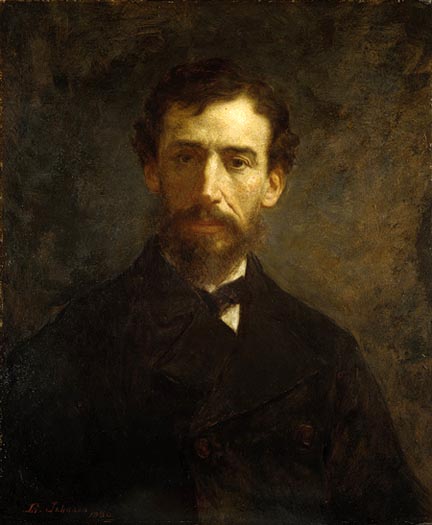
1823 - 1880

Johnson's sensitive portrayal of the landscape painter Gifford, his friend and neighbor in the Tenth Street Studio Building, formerly in lower Manhattan, was executed in the year of Gifford's death. Originally owned by Gifford's widow, it was bequeathed to Richard Butler, one of Gifford's most avid patrons, who instantly donated it to the Metropolitan Museum. Both men were founders of the Museum, which in 1881 accorded Gifford the first monographic show ever mounted by the institution. Johnson's warm, ruminative characterization of the artist may well be posthumous; the quiet self-possessed stare yet faintly melancholic repose of the sitter's visage are further complicated by the strong ambiguity of light and dark dividing it, seeming to illustrate emotional conflicts perceived by another of his close friends and revealed in a eulogy to the artist: "His character ... was serene and placid, resting on resources within himself. That placidity of the surface was an indication of the depth of the stream that flowed within, whose floods, and swirls, and eddies often caught him from the light and carried him into cavernous depths of shade."
Sanford Robinson Gifford was an American landscape painter and one of the leading members of the Hudson River School. Gifford's landscapes are known for their emphasis on light and soft atmospheric effects, and he is regarded as a practitioner of Luminism, an offshoot style of the Hudson River School.
Gifford was born in Greenfield, New York and spent his childhood in Hudson, New York, the son of an iron foundry owner. He attended Brown University 1842-44 before leaving to study art in New York City in 1845. He studied drawing, perspective and anatomy under the direction of the British watercolorist and drawing-master, John R. Smith. He also studied the human figure in anatomy classes at the Crosby Street Medical College and took drawing classes at the National Academy of Design. By 1847 he was sufficiently skilled at painting to exhibit his first landscape at the National Academy and was elected an associate in 1851, an academician in 1854. Thereafter Gifford devoted himself to landscape painting, becoming one of the finest artists of the early Hudson River School.
Like most Hudson River School artists, Gifford traveled extensively to find scenic landscapes to sketch and paint. In addition to exploring New England, upstate New York and New Jersey, Gifford made extensive trips abroad. He first traveled to Europe from 1855 to 1857, to study European art and sketch subjects for future paintings. During this trip Gifford also met and traveled extensively with Albert Bierstadt and Worthington Whittredge.
In 1858, he traveled to Vermont, apparently with his friend and fellow painter Jerome Thompson. Details of their visit were carried in the contemporary Home Journal. Both artists submitted paintings of Mount Mansfield, Vermont's tallest peak, to the National Academy of Design's annual show in 1859. 'Thompson's work, 'Belated Party on Mansfield Mountain', is now owned by the Metropolitan Museum of Art in New York,' according to the report.
Mount Mansfield: 1858
by Sanford Robinson Gifford
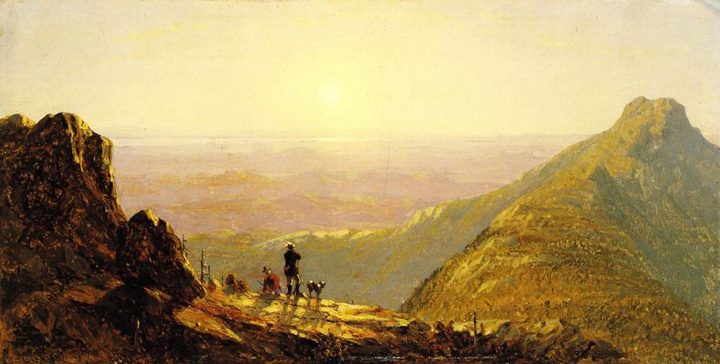
This is one of Gifford's largest canvases, a work he designated a 'Chief Picture' in his output, by which he meant that it embodied important ideas in a striking way. He had just returned from a long tour of Europe and was anxious to incorporate his experiences into a valid American landscape art. Here, in one of the earliest pictures to show Vermont's grand scenery, his intention may have been to 'Americanize' the brilliant light of Italy.
The Belated Party on Mansfield Mountain: 1858
by Jerome Thompson
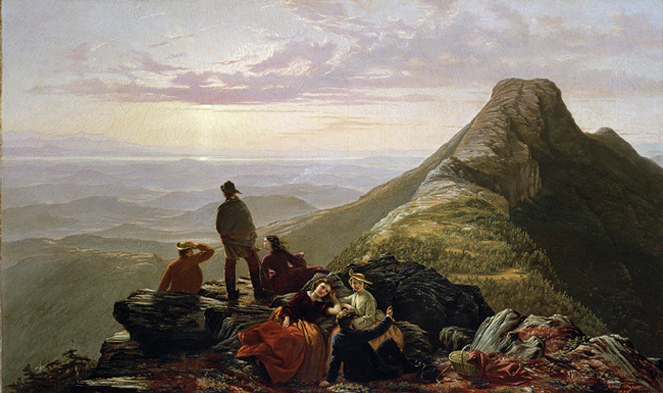
In the era when American landscapes were as popular as accounts of everyday life, Thompson achieved a balance in his work between nature and familiar human relations. Atop Mount Mansfield in Vermont's Green Mountains, a group of young men and women are resting after a day of hiking and picnicking and are enjoying the view of the vast Champlain Valley. As the sun sets and the evening breeze picks up, one sensible fellow holds up his watch to warn that they must soon depart. His companions ignore him, caring not that their way down the mountain will soon become difficult, even perilous. They are enraptured by the moment, the beauties of nature, and the possibilities of courtship at dusk.
Thereafter, he served in the Union Army as a corporal in the 7th Regiment of the New York Militia upon the outbreak of the Civil War. A few of his canvases belonging to New York City's Seventh Regiment and the Union League Club of New York are testament to that troubled time.
Sunday Morning in the Camp of the Seventh Regiment near Washington, D.C.

Some of the sketchbook studies of soldiers in various seated and reclining positions that were used for the Arlington Heights scene were also the models used for figures in a daylight view, Sunday Morning in the Camp of the Seventh Regiment Near Washington, DC. The yellow green open field of a parade ground, overlooking the city on the Potomac in the blue haze in the distance, is the tree framed setting for Sabbath Services. Clusters of soldiers (several in exotic, red Zouave dress, and others in the buff and gray of the earliest Union uniforms)... direct their attention to the black robed speaker at the flag-draped podium in front center. In Europe Gifford had an eye for spectacles in which many people were contained in a wide landscape or a large space. A military mass for veterans at "Les Invalides" was pronounced a touching sight." At the start of what was believed in the North to be a righteous war, the American counterpart of such a service, which touched many chroniclers of army life, was naturally of great interest to him.
The Camp of the Seventh Regiment near Frederick, Maryland: 1863
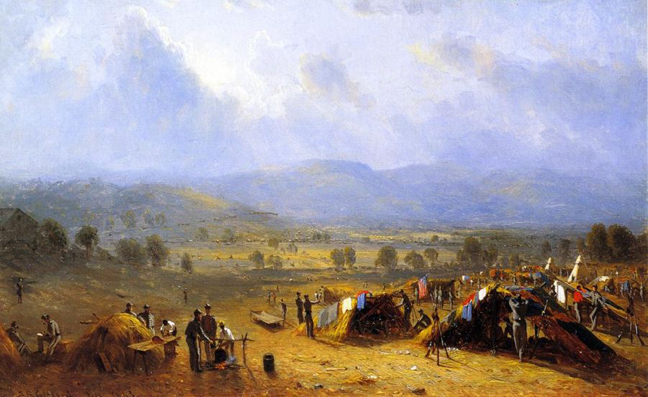
The Basin of the Patapsco from Federal Hill, Baltimore

Sanford Robinson Gifford during the Civil War
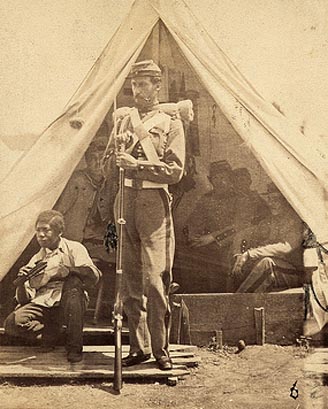
During the summer of 1867, Gifford spent most of his time painting on the New Jersey coast, specifically at Sandy Hook and Long Branch. 'The Mouth of the Shrewsbury River', one noted canvas from the period, is a dramatic scene depicting a series of telegraph poles extending into an atmospheric distance underneath ominous storm clouds.
Long Branch Beach: 1867
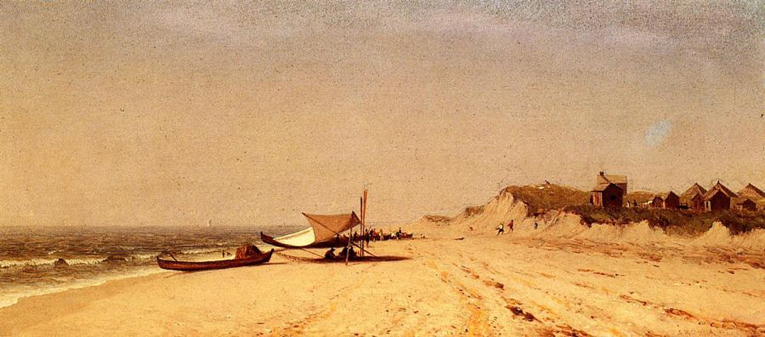
The Mouth of the Shrewsbury River: 1867
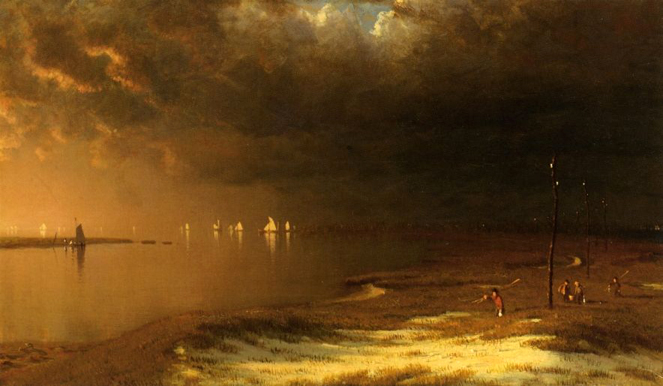
Another journey, this time with Jervis McEntee and his wife, took him across Europe in 1868. Leaving the McEntees behind, Gifford traveled to the Middle East, including Egypt in 1869. Then in the summer of 1870 Gifford ventured to the Rocky Mountains in the western United States, this time with Worthington Whittredge and John Frederick Kensett. At least part of the 1870 travels were as part of a Hayden Expedition, led by Ferdinand Vandeveer Hayden.
Returning to his studio in New York City, Gifford painted numerous major landscapes from scenes he recorded on his travels. Gifford's method of creating a work of art was similar to other Hudson River School artists. He would first sketch rough, small works in oil paint from his sketchbook pencil drawings. Those scenes he most favored he then developed into small, finished paintings, then into larger, finished paintings.
Gifford referred to the best of his landscapes as his 'chief pictures'. Many of his chief pictures are characterized by a hazy atmosphere with soft, suffuse sunlight. Gifford often painted a large body of water in the foreground or middle distance, in which the distant landscape would be gently reflected. Examples of Gifford's 'chief pictures in museum collections today include:
Lake Nemi (1856-57)
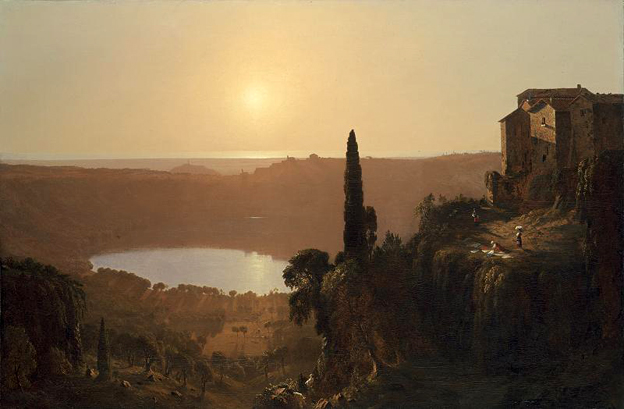
Lake Nemi (1856-57), a work that Gifford painted for exhibit in New York while in Italy, is the first of his paintings to have the sun as a focal point of the painting using light and tone to unifying and simply the landscape. This was to become a trademark of his work. We can trace his fascination with the transfiguring effects of light on the natural landscape throughout the exhibits in such works as 'A Gorge in the Mountains' (1859) 'Mansfield Mountain' (1859) and 'The Wilderness' (1860).
The Wilderness (1861)
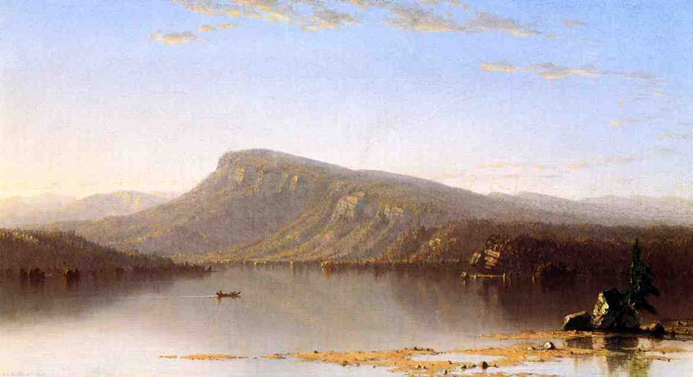
In "The Wilderness," an 1860 painting that is in the collection of the Toledo Museum of Art, Gifford depicts some Indians on the shore of a lake with a majestic mountain in the distance. It has been noted that "Although likely not meant to portray a specific mountain in an identifiable location, the shape of the peak in 'The Wilderness' suggests that of Mount Katahdin in Maine."
A Passing Storm (1866)
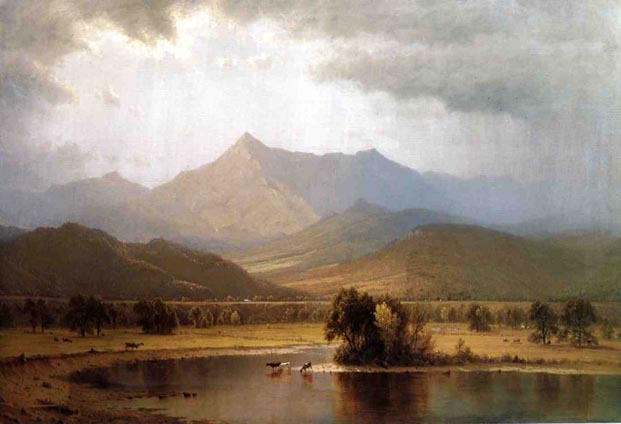
Ruins of the Parthenon (1880)
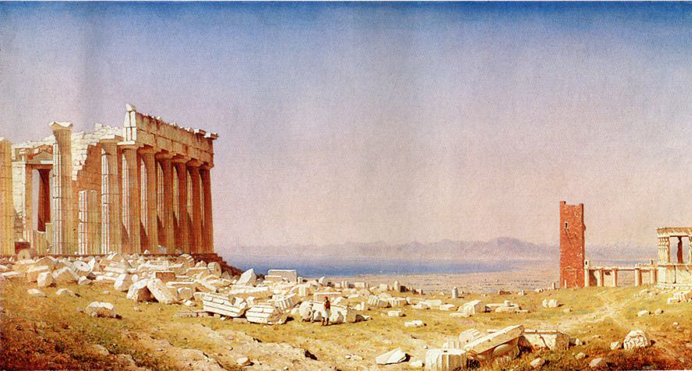
The Ruins of the Parthenon was Sanford Gifford's last important painting, and he considered it the crowning achievement of his career. Based on sketches he made on a visit to the Acropolis in May 1869, the painting, according to Gifford, was "not a picture of a building, but a picture of a day." Much the same might be said of the majority of his works, for he was unsurpassed in his ability to capture the subtleties and nuances of an astounding range of light and atmosphere. Gifford's mature works-and this is a prime example-are less about the specific physical facts of the scenes they portray (although those are not unimportant), and more about the very act of perception and vision. As one of his friends observed, "Gifford's art was poetic and reminiscent. . . . It was nature passed through an alembic (a device that refines or transmutes through distillation) of a finely organized sensibility..."
On August 29, 1880, Gifford died in New York City, having been diagnosed with malarial fever. The Metropolitan Museum of Art in New York City celebrated his life that autumn with a memorial exhibition of 160 paintings. A catalog of his work published shortly after his death recorded in excess of 700 paintings during his career.
Between 1955 and 1973, Gifford's heirs donated the artist's collection of letters and personal papers to the Archives of American Art, a research center which is part of the Smithsonian Institution. In 2007, these papers were digitally scanned in their entirety and made available to researchers as the Sanford Robinson Gifford Papers Online.
Mount Mansfield Paintings/Controversy
Gifford painted some 20 paintings from the sketches he did while in Vermont in 1858. Of these, 'Mount Mansfield, 1858' was the National Academy submission in 1859, and another painted in 1859, 'Mount Mansfield, Vermont', came in 2008 to be in the center of a controversy over its sale by the National Academy in New York. The controversy had been reported in December, saying that the sale of paintings to cover operating expenses was against the policy of the Association of Art Museum Directors, which organization in turn was asking its members to "cease lending artworks to the academy and collaborating with it on exhibitions." The report also said the 1859 painting in question was "donated to the academy in 1865 by another painter, James Augustus Suydam." Among much more detail about the sale, a later Times report said that the National Academy had sold works by Thomas Eakins and Richard Caton Woodville in the 1970's and 1990's respectively, according to David Dearinger, a former curator. "When the academy later applied to the museum association for accreditation, Mr. Dearinger recalled, it was asked about the Woodville sale and promised not to repeat such a move," the Times reported. News of the sale was originally broken, as reported in the Times, by arts blogger Lee Rosenbaum. As cited by Rosenbaum, her original story, with additional details on other contemplated sales by the Academy, ran December 5. The Times did subsequently report on the other contemplated sales, without credit to Rosenbaum.
From: Wikipedia
Various Landscapes and Paintings of Sanford Robinson Gifford
Kenilworth Castle: 1858

Kenilworth Castle is a castle located in Kenilworth, Warwickshire, England . Historically the Castle was contained within the Forest of Arden.
The medieval castle is notable for its extensive water defenses, and the great siege by the future Edward I in 1266, plus the ruins of the ornate Great Hall built by John of Gaunt. Its later history includes the visit of Elizabeth I (it still boasts Tudor buildings and gardens) and the dramatic slighting by Cromwell's troops, leaving an open side to the fine Norman keep.
A fortification has existed on the site from Saxon times, but the current ruin is of Norman origin; a great square stone tower built by Geoffrey de Clinton, Treasurer and Chief Justice of England to Henry I, in about 1125. Henry II took control of the castle during the Revolt of 1173-1174, giving the Clintons another castle in Buckinghamshire by way of compensation.
Work then began to improve the defensive qualities of the castle, continuing during the reign of Henry III and transforming the castle into one of the strongest in the Midlands. The strategic advantages of water defenses had long been known, and at Kenilworth a great manmade lake was created to defend three sides of the castle. Covering over 100 acres it was an expensive endeavor, but the value in keeping siege engines at a distance and as a barrier to assault or mining was immense.
However, after all the work to improve the castle, Henry III granted it in 1244 to Simon de Montfort, Earl of Leicester. Simon de Montfort became a leader in the Second Barons' War (1263-1267) against Henry III, using Kenilworth as the center of his operations. Prince Edward, Henry's heir, was once briefly imprisoned at Kenilworth before escaping. De Montfort was killed in battle near Evesham on August 13, 1265 facing Edward. In 1266, the rebels under the leadership of Henry de Hastings, used the castle as a refuge when Lord Edward surrounded Kenilworth. The Siege of Kenilworth Castle in 1266 is the longest in English history. The extensive water defenses provided their intended protection, despite Edward targeting the weaker north wall, defended by only a double moat, employing huge siege towers and even attempting a night attack by barge. The siege was ended on easy terms for the defenders with the Dictum of Kenilworth. The experience gained in water defenses at Kenilworth was put to good effect at later castles built in Wales, notably Caerphilly.
Henry III bestowed the castle upon his youngest son Edmund Crouchback. The castle was inherited by Edmund's grandson Henry of Grosmont, 1st Duke of Lancaster, and then passed to the Duke's son-in-law John of Gaunt.
From 1364, John of Gaunt began the castle's conversion from a pure fortress into something more livable, work that continued with his grandson, Henry V. The castle remained in royal hands until it was given to John Dudley in 1553. Following his execution Elizabeth I gave it to her favorite Robert Dudley, Earl of Leicester in 1563. Thomas Underhill was named Keeper of the Wardrobe at this time. Dudley further transformed the castle by making the north entrance the main entrance to suit the tastes of Elizabeth, adding the Leicester building, a large apartment and a residential block overlooking the lake.
Elizabeth visited Dudley at Kenilworth Castle several times in 1566, 1572, and 1575. The last visit is especially remembered, when Elizabeth brought an entourage of several hundred. No expense was spared for the July visit that lasted 19 days and is reputed to have cost Dudley £1000 per day, an amount that almost bankrupted him. Dudley entertained the Queen with pageants, bear baiting and lavish banquets that surpassed anything ever before seen in England.
The festivities are said to have been the inspiration for Shakespeare's 'A Midsummer Night's Dream'. William Shakespeare was just 11 years old at the time and from nearby Stratford-upon-Avon. He could well have been among the crowd of locals that would have gathered to witness the occasion with its expensive and lavish arrangements.
Sir Walter Scott wrote an 1821 novel describing the royal visit, and Sir Arthur Sullivan wrote a choral work in 1864 about it. Elizabeth is said, according to local legend, to have tasted the first potato brought into the country at Kenilworth Castle. Unfortunately, she ate it raw, disliked it and threw it out the window where it grew in an area now known as Little Virginia.
The castle returned to the Crown on Dudley's death. In the English Civil War, the castle was stormed and looted by Parliamentarian troops. In common with many English castles, Kenilworth was slighted (rendered indefensible) after the Civil War. One wall of the keep was blown up, and battlements and the great water defenses were destroyed, in 1656.
In 1660 Charles II gave the castle to Sir Edward Hyde, whom he created Baron Hyde of Hindon and Earl of Clarendon. The castle remained the property of the Clarendons until 1937 before passing into the possession of John Davenport Siddeley, 1st Baron Kenilworth. The family presented the castle to Kenilworth in 1958 and English Heritage has looked after it since 1984.
La Marina Grande, Capri: 1861
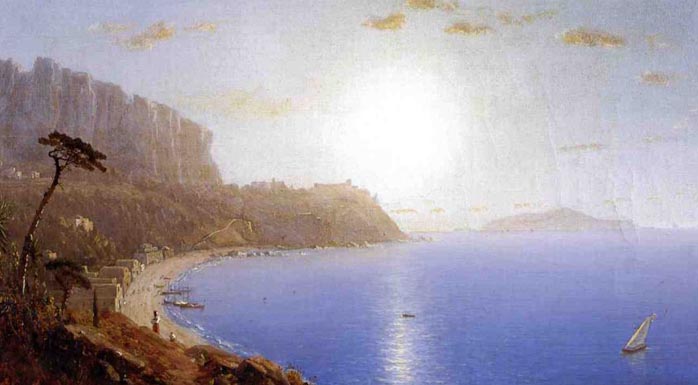
La Riviera di Ponente, Genoa: 1856
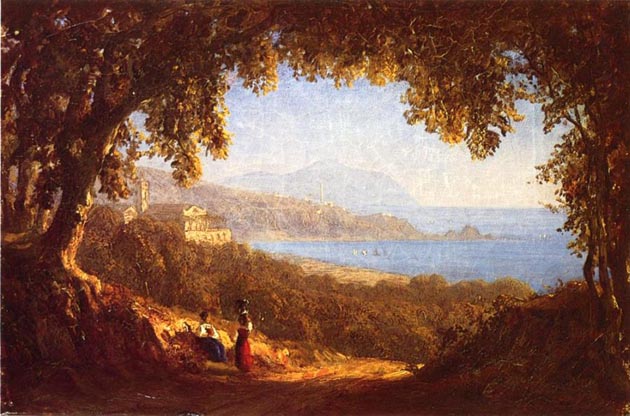
Lago di Garda, Italy: 1863
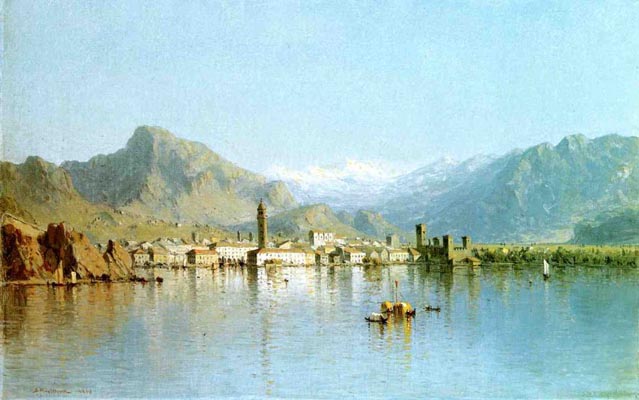
"Gifford's meticulous recording of the buildings makes a number of them easily identifiable, including the tall structure at the left, Torre di Apponale, which was built in 1220 for defense of the town and later raised in height and extensively modified (into a clock tower). At the far right is the multi-towered castle known as the Rocca, first constructed in the twelfth century and renovated and enlarged several times since. Seen between these two, but slightly further inland, is the south flank of the church of Santa Maria Assunta, begun in the early twelfth century but completely redecorated in 1728."
Lake Como: 1867
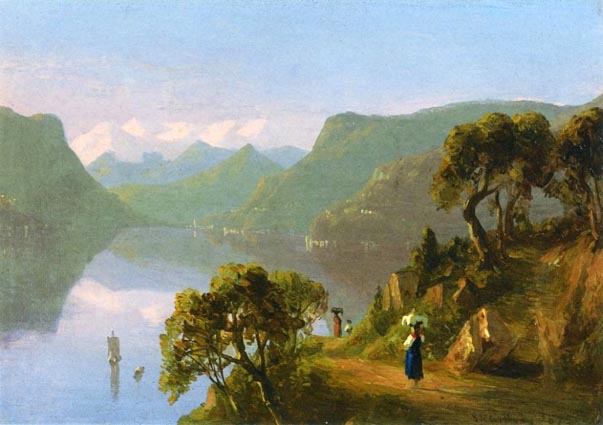
Landscape with Village in the Distance: 1853
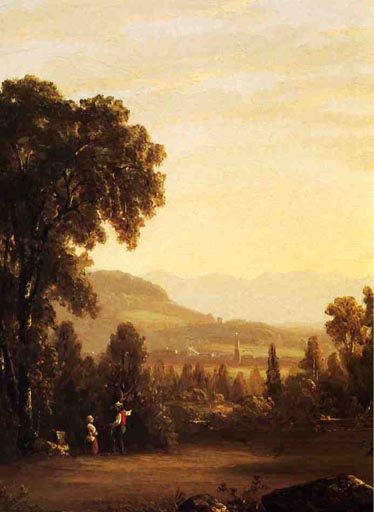
Study of Windsor Castle: 1855
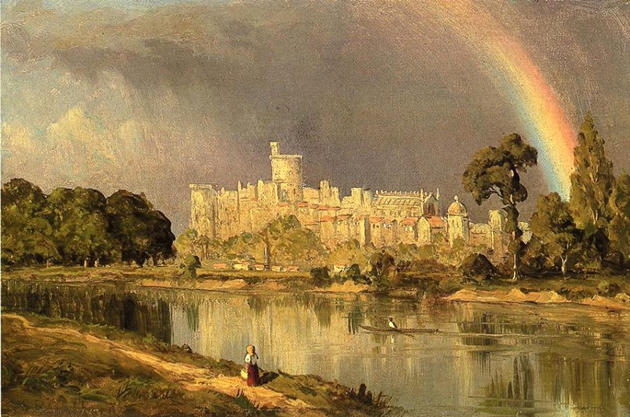
Windsor Castle: 1860
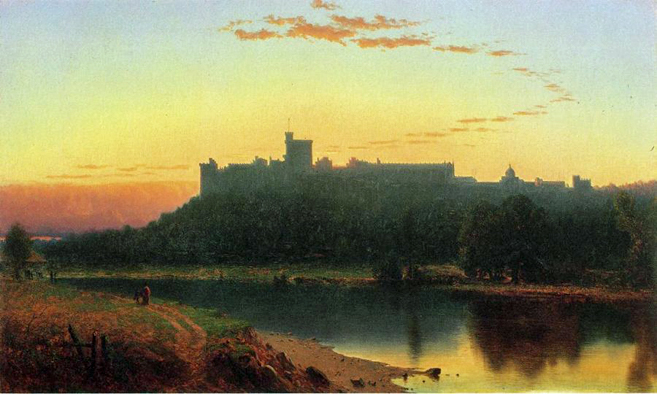
Windsor Castle, in Windsor in the English county of Berkshire, is the longest inhabited castle in the world and, dating back to the time of William the Conqueror, is the oldest in continuous occupation. The castle's floor area is approximately 484,000 square feet.
Together with Buckingham Palace in London and Holyrood Palace in Edinburgh, it is one of the principal official residences of the British monarch. Queen Elizabeth II spends many weekends of the year at the castle, using it for both state and private entertaining. Her other two residences, Sandringham House and Balmoral Castle, are the Royal Family's private homes.
Most of the Kings and Queens of England, later Kings and Queens of Great Britain, and later still kings and queens of the United Kingdom and the other Commonwealth realms, have had a direct influence on the construction and evolution of the castle, which has been their garrison fortress, home, official palace, and sometimes their prison.
King Edward III was born in the castle on 13 November 1312, and was often referred to as "Edward of Windsor". Beginning in 1350, he initiated a 24-year rebuilding program by demolishing the existing castle, with the exception of the Curfew Tower and some other minor outworks. He placed William of Wykeham in overall charge of the rebuilding and design of the new castle. Henry II's keep (the Round Tower) was replaced by the present keep, although it was not raised to its present height until the 19th century. The fortifications too were further increased. The castle's chapel was substantially enlarged, but plans to build a new church were not executed, probably due to the scarcity of manpower and resources following the Black Death. Also dating from this time is the Norman Gate. This large and imposing gate at the foot of the 'Round Tower' is the last bastion of defense before the 'Upper Ward' where the Royal Apartments are situated.
Norman Gate, Windsor Castle
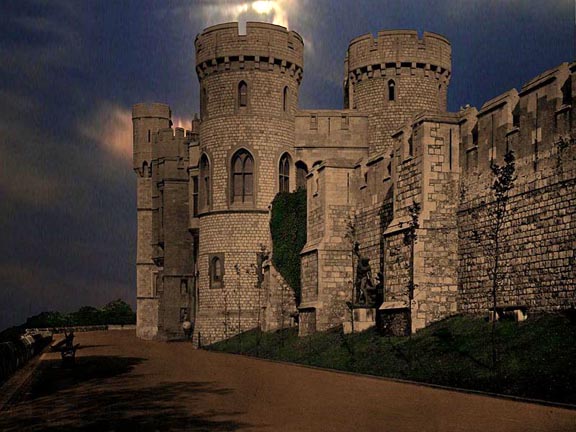
In 1348 King Edward III established the Order of the Garter, whose annual ceremony still takes place in Saint George's Chapel, the principal chapel of the castle. In 1353-1354, he had the Aerary Porch built.
Windsor, Saint George's Chapel
by Bailey Joseph Nash: 1848
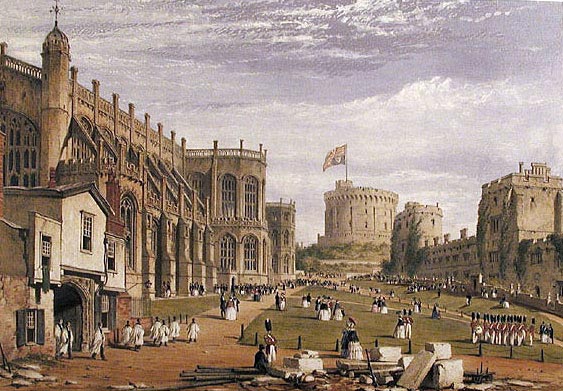
During the reign of Richard II, it was discovered that Saint George's chapel was close to collapse, and a restoration process was undertaken. The clerk of the works was one of King Richard's favorites, Geoffrey Chaucer, who served as a diplomat and 'Clerk of The King's Works'. Whatever his skills as a surveyor and builder were, within 50 years of his restoration the chapel was again ruinous.
King Edward IV (1461-1483), the first Yorkist King, who was said to be addicted to "the advauncement of vaine pompe" (sic), began the construction of the present Saint George's Chapel. In reality the chapel, begun in 1475, is more a miniature cathedral and royal mausoleum than a chapel. Its architecture is an exercise in the Perpendicular Gothic style. During the reign of Henry VII, some of the original Chapel of Saint George was demolished to make way for the Lady Chapel, which the King then abandoned. The building was one of the first truly grand pieces of architecture within the castle precincts.
Flying Buttresses, Saint George's Chapel
(Perpendicular Gothic)
.jpg)
The construction of the chapel marked a turning point in the architecture of the castle. The more stable political climate following the end of the Wars of the Roses meant that future building tended to be more considerate of comfort and style than of fortification. In this way the castle's role changed from that of royal bastion to that of a royal palace. One example of this is the "Horseshoe Cloister" from 1480, built near the chapel to house its clergy. This curved brick building is said to be in the shape of a fetlock: one of the badges used by Edward IV. Restoration work in 1871 was heavy, and little of the original building remains.
Horseshoe Cloister and Curfew Tower
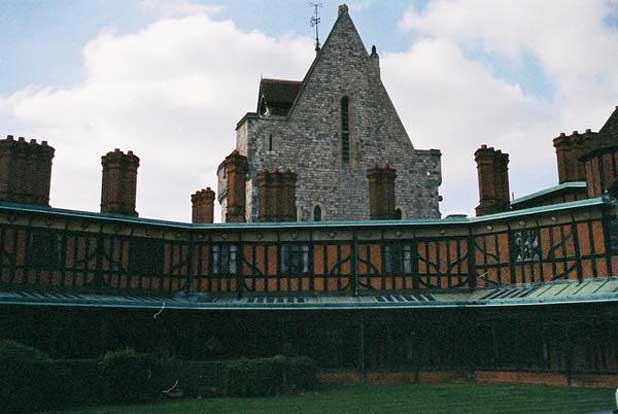
The Horseshoe-Windsor
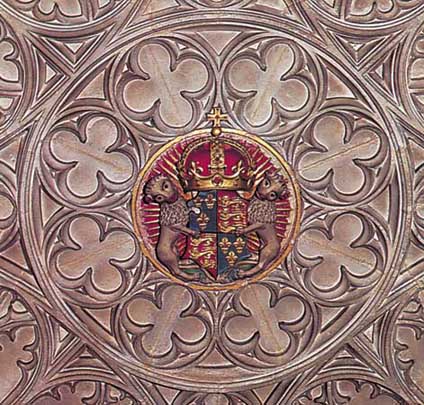
Elizabeth I and her court left the outbreak of 'Bubonic Plague - Black Death' - in London, for Windsor Castle in 1563. There she had a gallows erected, ordering anyone visiting from London to be executed. Elizabeth I attempted to avoid the spread of the disease through prohibiting foreign imports and cutting down on public gatherings.
Elizabeth I was followed by James I, and he by his son Charles I, neither of whom made significant changes to the castle. However, following the deposition of Charles in the English Civil War, the castle became the headquarters of Oliver Cromwell's New Model Army. Windsor Castle fell to Cromwell's Parliamentarians early in the hostilities due to the cunning of Colonel John Venn. Prince Rupert of the Rhine arrived to retake the town and castle a few days later, but though he severely battered the town, he was unable to retake the castle. Venn remained Governor of the castle until 1645.
Under Parliamentarian jurisdiction the castle suffered, but not as badly as such an iconic symbol of monarchy could have been expected to. However, the garrison stationed there was underpaid and was allowed to loot the castle's treasures. For the duration of the Commonwealth period, the castle remained a military headquarters, and a prison for more important Royalists captured. For a short time prior to his execution in 1649, Charles was imprisoned in the castle, although in today's terminology house arrest would be a more accurate term. Following the King's execution, Britain was ruled by Oliver Cromwell until the Restoration of the Monarchy in 1660. Charles' body was smuggled back to Windsor in the dead of night through a snowstorm to be interred without ceremony in the vault beneath the choir in Saint George's Chapel, next to the coffins of Henry VIII and his wife Jane Seymour.
The Restoration of the Monarchy in 1660 was to prove the first period of significant change to Windsor Castle for many years. Charles II did much to restore and refurnish the castle from the damage suffered during the civil war. At this time Versailles was being constructed in France, and with this in mind Charles II laid out the avenue known as the Long Walk. Running south from the castle, this avenue runs for three miles and is 240 feet wide. The original elms the King planted have since been replaced with chestnuts and planes. The Long Walk was not the only part of Windsor to be inspired by Versailles. Charles II commissioned the architect Hugh May to rebuild the Royal Apartments and Saint George's Hall. May replaced the original Plantagenet apartments on the north terrace with the cube-like Star Building. The interiors of these new apartments were decorated with ceilings by Antonio Verrio and carving by Grinling Gibbons. The King also acquired tapestries and paintings to furnish the rooms. These artworks were to form the core of what was to become known as the Royal Collection. Three of these rooms survive relatively unchanged: the Queen's Presence Chamber and the Queen's Audience Chamber, both designed for Charles II's wife Catherine of Braganza, and the King's Dining Room. These retain both their Verrio ceilings and Gibbons' paneling. Originally there were twenty rooms in this style. Some of Gibbons' carvings were rescued at various times when alterations were being made in the name of change or restoration, and in the 19th century these carvings were incorporated into new interior design themes in the 'Garter Throne Room' and the 'Waterloo Chamber'.
The Queen's Presence Chamber, Windsor Castle: 1819
.jpg)
Queen's Audience Chamber, Windsor Castle: 1819
.jpg)
King's Dining Room, Windsor Castle
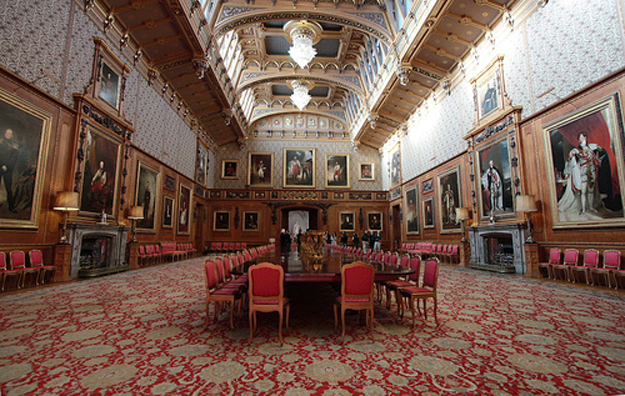
Garter Throne Room, Windsor Castle
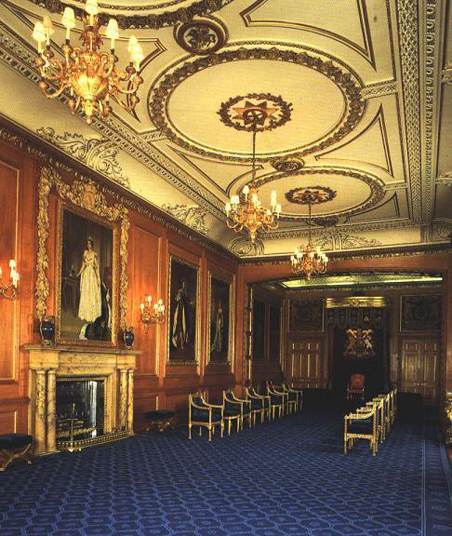
The Waterloo Chamber, Windsor Castle
by Joseph Nash
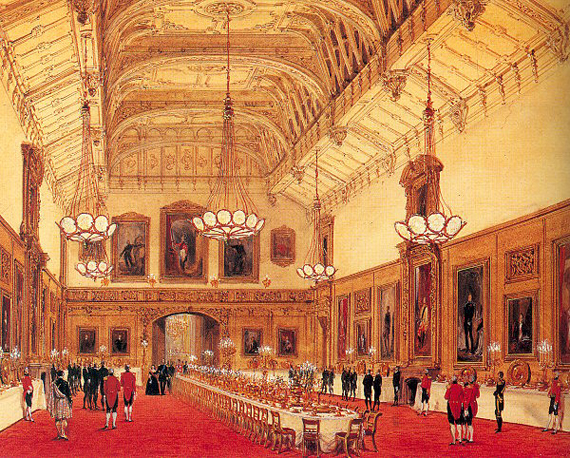
Following the death of Charles II in 1685, the Castle fell slowly into a state of neglect. While the precincts and park remained a complex of inhabited royal mansions, the sovereigns themselves preferred to live elsewhere. During the reign of William and Mary (1689-1702), Hampton Court Palace was enlarged and transformed into a huge modern palace. Later Queen Anne preferred to live in a small house close to the walls of the castle. It was not until 1804- when King George III, the father of 13 children, needed a larger residence than could be found elsewhere- that the castle was once again fully inhabited. The work carried out by Charles II had been on the contemporary, more classical, style of architecture popular at the time. Inigo Jones had introduced Palladianism to England during the time of Charles I; George III felt this style was not in keeping with an ancient castle, and had many of Charles II's windows redesigned and given a pointed Gothic arch, and thus the castle began once again to acquire its original medieval appearance. During this period Windsor Castle was once again to become a place of royal confinement. In 1811 King George III became permanently deranged and was confined to the castle for his own safety. During the last nine years of his life he seldom left his apartments at Windsor.
It was during the reign of King George IV between 1820-1830 that the castle was to undergo the greatest single transformation in its history. George IV, known for his extravagant building at both Carlton House and the Royal Pavilion during his regency, now persuaded Parliament to vote him £300,000 for restoration. The architect Jeffry Wyatville was selected, and work commenced in 1824.
The work took twelve years to complete and included a complete remodeling of the Upper Ward, private apartments , Round Tower, and the exterior facade of the South Wing which gave the castle its near symmetrical facade seen from the Long Walk.
Wyatville was the first architect to view the castle as one composition, rather than a collection of buildings of various ages and in differing styles. As an architect he had a preference for imposing symmetry, whereas the castle which had evolved piecemeal over the previous centuries had no symmetry at all. Wyatville imposed a symmetry of sorts on the existing buildings of the Upper Ward, by raising the heights of certain towers to match others, and re-facing the Upper Ward in a Gothic style complete with castellated battlements to match the medieval buildings, including Saint George's Chapel in the Lower Ward. The Round Tower had always been a squat structure, and now this was further accentuated by the new height of the buildings in the Upper Ward. Wyatville surmounted this problem by building on top of the Round Tower a hollow stone crown, basically a false upper storey. Some 33 feet high, this crown gives the entire castle its dramatic silhouette from many miles away.
The Last Great Epoch in the History of the Castle
by William Harrison Ainsworth
Much of the interior of the Castle was given the same makeover treatment as the exterior. Many of the Charles II state rooms which remained after George III's redecorations were redesigned in the Gothic style, most notably Saint George's Hall, which was doubled in length. Wyatville also roofed over a courtyard to create the Waterloo Chamber. This vast hall lit by a clerestory was designed to celebrate the victors of the Battle of Waterloo and was hung with portraits of the allied sovereigns and commanders who vanquished Napoleon. The large dining table at the centre of the chamber seats 150 people.
The work was unfinished at the time of George IV's death in 1830, but was virtually completed by Wyatville's death in 1840.
Saint George's Hall, Windsor Castle
from W. H. Payne's Royal Residences: 1819
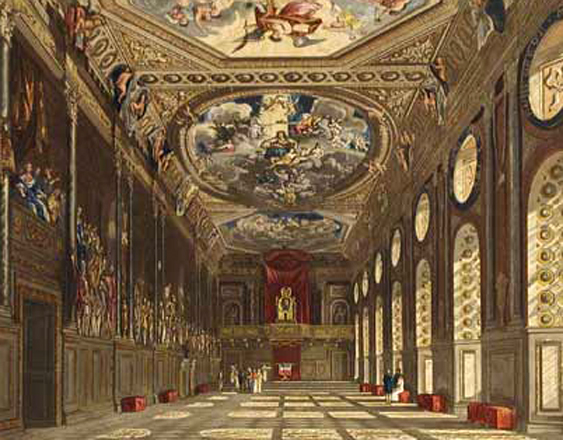
Saint George's Hall
by Joseph Nash: 1848
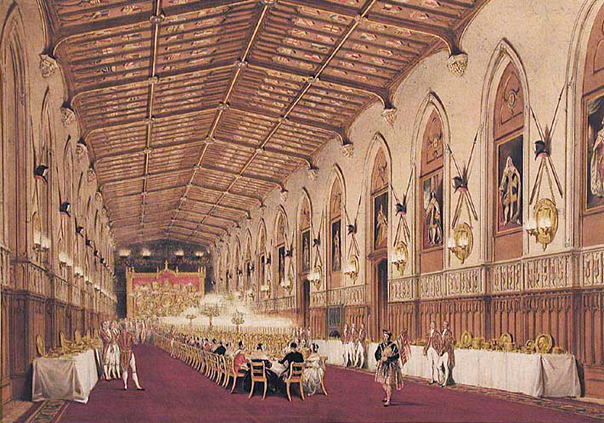
Queen Victoria and Prince Albert made Windsor Castle their principal royal residence. Many of their changes were to the surrounding parklands rather than the buildings. In particular, the 'Windsor Castle and Town Approaches Act', passed by Parliament in 1848, permitted the closing and re-routing of the old roads which previously ran through the park from Windsor to Datchet and Old Windsor. These changes allowed the Royal Family to undertake the enclosure of a large area of parkland to form the private 'Home Park' with no public roads passing through it.
Windsor Castle in Modern Times
by Sir Edwin Landseer: 1841-1845

Queen Victoria had retreated to Osborne House on the Isle of Wight for privacy following the death in 1861 of Prince Albert in the Blue Room at Windsor Castle. Albert was buried in the Royal Mausoleum built at nearby Frogmore, within the Home Park of the Castle and eventually Victoria was buried beside him.
From Albert's death until her own death in 1901, Windsor Castle was one of Victoria's main homes, and she seldom visited Buckingham Palace again. Her other homes were Balmoral Castle in Scotland and Osborne House on the Isle of Wight. The prince's rooms were maintained exactly as they had been at the moment of his death, and although an air of melancholy was allowed to settle on the castle for the remainder of the 19th century, this did not prevent improvements and restoration from taking place. In 1866 Anthony Salvin created the Grand Staircase in the State Apartments. This great stone staircase in the Gothic style rises to a double height hall lit by a vaulted lantern tower. The hall is decorated with arms and armor, including the suit of armor worn by King Henry VIII, made in 1540. The top of the stairs are flanked by life-size equestrian statues mounted by knights in armor. This theme of decoration continues into the Queen's Guard Chamber and the Grand Vestibule. Salvin also added the château-style conical roof to the 'Curfew Tower' at this time. John Sparrow David Thompson, 4th Prime Minister of Canada, died in the castle suddenly, while in office, of a heart attack in 1894.
Victoria Memorial at Windsor
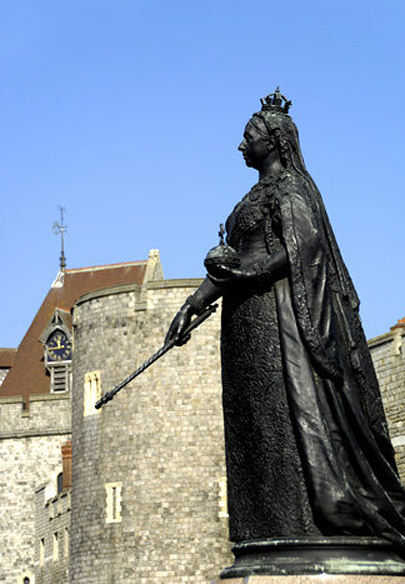
Following the accession of King Edward VII in 1901, the castle often remained empty for long periods, the new King preferring his other homes elsewhere. The King visited for Ascot week and Easter. One of the few alterations he made was to lay out the castle's golf course. A footnote to history is that the current official length of the marathon race is derived from the distance from Windsor Castle to Olympic Stadium in London. The dramatic finish of the 1908 Olympic Marathon (which began in front of the castle) led to that distance becoming popular, and subsequently official.
Edward VII's successor George V, who was King from 1910 until his death in 1936, also preferred his other country homes. However, his wife Queen Mary was a great connoisseur of the arts, and not only sought out and re-acquired long-dispersed items of furniture from the castle, but also acquired many new works of art to furnish the state rooms. She also rearranged the fashion in which the castle was used, abandoning the baroque idea of a large suite of state rooms reserved just for important guests on the principal floor. New, more comfortable bedrooms with modern bathrooms were installed on the upper floors, allowing the formerly reserved state rooms below to be used for entertaining and court functions. The state bedroom itself was retained, but more as a historical curiosity. It has not been used as a bedroom since 1909.
During the First World War, when the members of the Royal Family felt the need to change its dynastic name from the German 'House of Saxe-Coburg and Gotha', they took their new name from the castle, becoming the 'House of Windsor'.
Queen Mary was a lover of all things miniature, and a large dolls' house was created for her, based on a large aristocratic mansion-it was designed by the architect Lutyens. Its furniture and picture were created by the great craftsmen and designers of the 1930's. The dolls' house today is one of the castle's many tourist attractions.
George VI came to the throne in 1936 following the abdication of his brother Edward VIII; on 11 December Edward had broadcast his abdication speech to the British Empire from the castle, but had preferred during his short reign to live at his home Fort Belvedere in Windsor Great Park. George VI and his wife Queen Elizabeth preferred their original Windsor home, Royal Lodge. On the outbreak of World War II in 1939 the castle resumed its role as a royal fortress, and the King and Queen and their children Princess Elizabeth (the future Queen Elizabeth II) and Princess Margaret lived, for safety, in the castle. The King and Queen drove daily to London, returning to Windsor to sleep, although at the time this was a well-kept secret, as for propaganda and morale purposes it was reported that the king was still residing full-time at Buckingham Palace. Following the cessation of hostilities in 1945, the Royal Family left Windsor Castle and returned to Royal Lodge.
In 1952, Queen Elizabeth II came to the throne and decided to make Windsor her principal weekend retreat. The private apartments which had not been properly occupied since the era of Queen Mary were renovated and further modernized, and the Queen, Prince Philip and their (then) two children took up residence. This arrangement has continued to the present day.
Windsor Fire: 1992
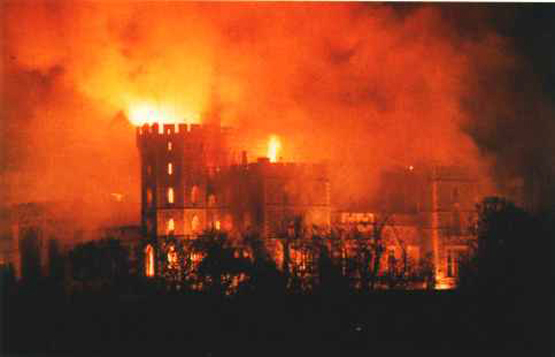
On 20 November 1992, a fire which began in the Queen's private chapel quickly spread. The fire raged for 15 hours until it had destroyed nine of the principal state rooms, and severely damaged over 100 more-in all the larger part of the upper ward. One-fifth of the floor space of the castle was damaged-an area of 9,000 square meters. The restoration program was not complete until 1997, 70% of it funded by the decision to open to the public for the first time the state rooms of Buckingham Palace. The total cost of repairing the damage was £37 million. The restoration was undertaken at no additional cost to the British taxpayer. So successful was the restoration and faithfulness to the original plans and decorations that the distinction between old and new is hard to detect. One example of this are the re-carving of 'The Queens Beast' which were totally recarved as close to the originals as possible by Gonzalez and Harms(see Ben Harms). Although some of the rooms that had been gutted by the fire were completely redesigned in a modern interpretation, the new design is very organic and of the Gothic style, called "Downesian Gothic" after the rooms' architect Giles Downes, of Sidell Gibson Partnership. These rooms include the new Private Chapel, the new Lantern Lobby and the new ceiling of Saint George's Hall. The last is made of green-oak, a technique used in medieval times. However, what is less obvious to the eye is that the restoration work resulted in significant improvements, particularly to the arrangements of the public rooms and the service quarters.
For some time, the Queen has increasingly used the castle as a royal palace as well as her weekend home. It is as often used for state banquets and official entertaining as Buckingham Palace. When during the great fire in 1992 Prince Andrew was interviewed for television, he stated that Windsor Castle was the one place the royal family regarded as home.
During the Queen's tenure of the Castle much has been done, not only to restore and maintain the fabric of the building, but also to transform it into a major British tourist attraction. This has had to be achieved in co-ordination with the castle's role as a working royal palace. In 1994, oil was discovered on the grounds of the Castle, and the Queen granted permission to sink an exploratory well to test the reserves, which experts predicted could be worth more than $1 billion. Any resulting profits would have been split between the oil company and the state.
In a June 1999 story, the BBC reported that Prince Charles was considering moving the royal court to Windsor Castle instead of Buckingham Palace when he ascends the throne. The story speculated that the Prince may be attempting to gain more independence from the traditional court at Buckingham Palace. The Palace has not commented on the story. Prince Charles, along with the rest of the royal family, is said to be fond of Windsor Castle.
Windsor Castle
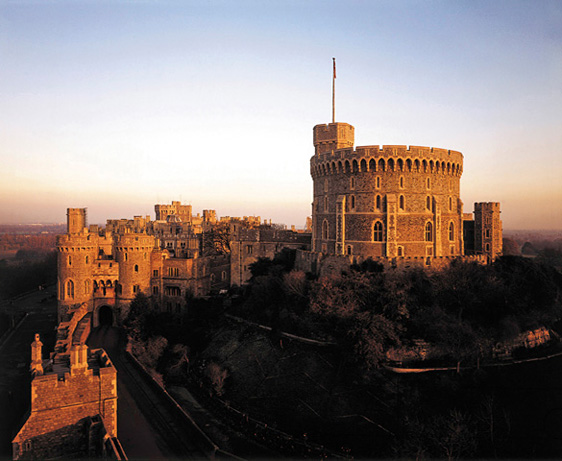
Windsor Castle Upper Ward Quadrangle
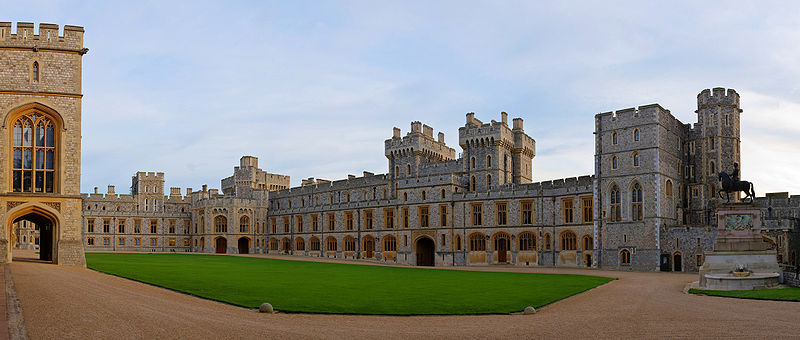
NOW - AFTER A SLIGHT DETOUR AT WINDSOR CASTLE - WE SHALL RETURN TO SANFORD ROBINSON GIFFORD
Shrine of Shakespeare: 1858
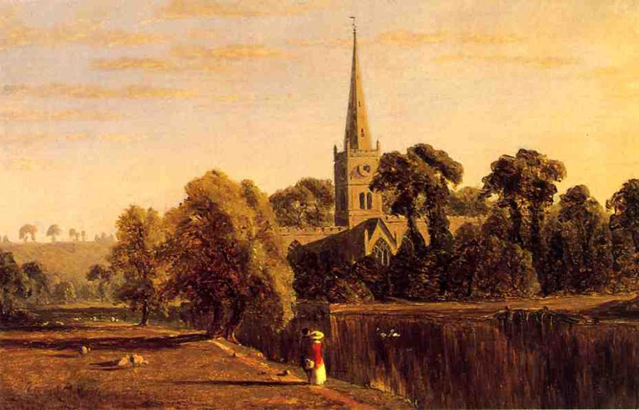
A Coming Storm: 1863
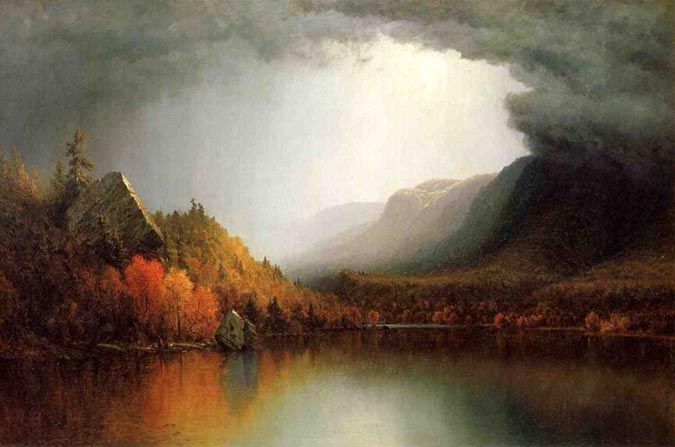
A Coming Storm on Lake George: 1863

A Forest Road: 1860
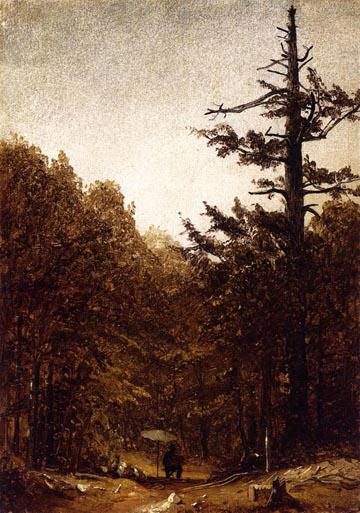
A Gorge in the Mountains: 1862
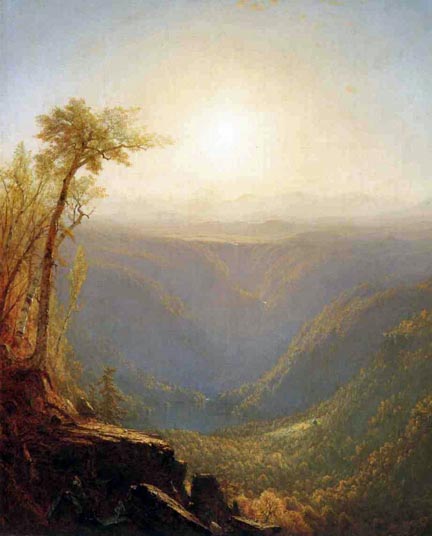
From 1845 until his death in 1880, Gifford chose Kauterskill Clove in the Catskill Mountains as one of his favorite subjects. This painting, dated 1862, was called "Kauterskill Falls" in the catalogue of the 1876 New York Centennial Loan Exhibition of Paintings, as well as in the 1881 official catalogue of Gifford's work. The title has since been changed to "Kauterskill Clove," for the view is from the east, looking west to Haine's Falls at the head of the clove.
A Home in the Wilderness: 1866
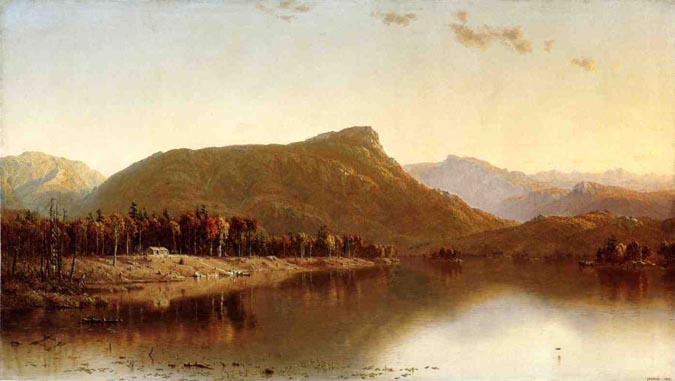
A Lake Twilight: 1861
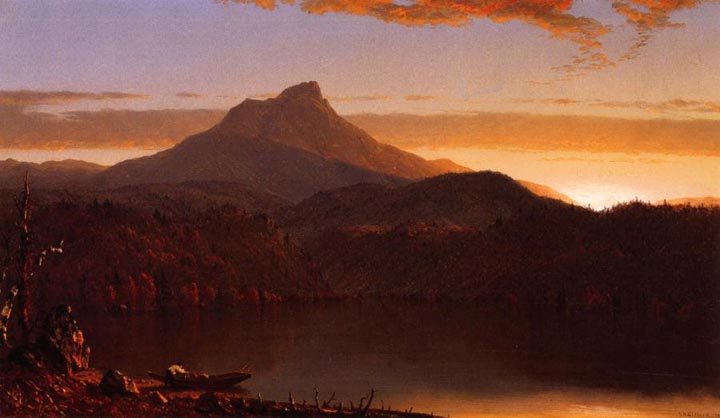
Mist Rising at Sunset in the Catskills: 1861
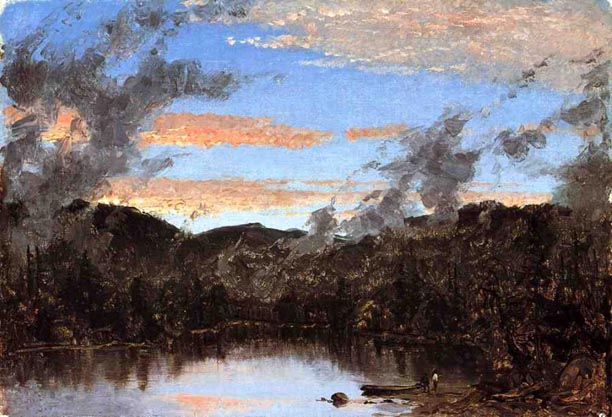
A Moment's Rest
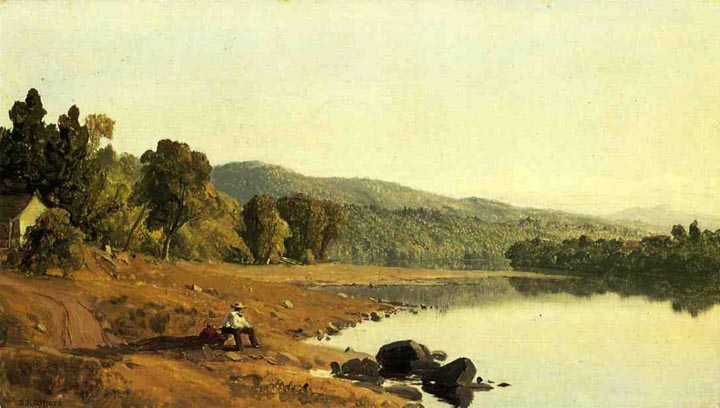
A Passing Storm in the Adirondacks: 1866

A Sketch from North Mountain, in the Catskills: 1865
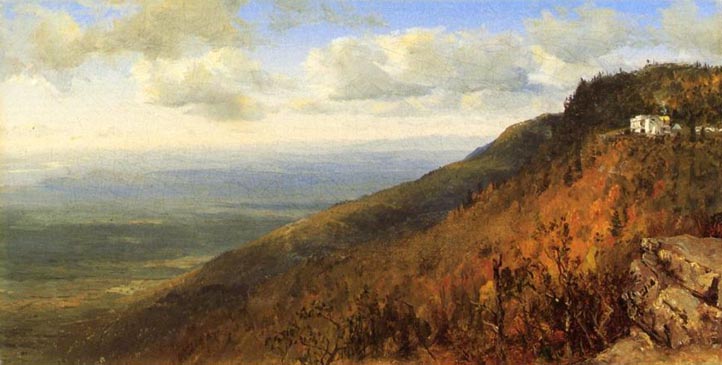
A Sketch in Kauterskill Clove: 1861

Kauterskill Clove, in the Catskills: 1862
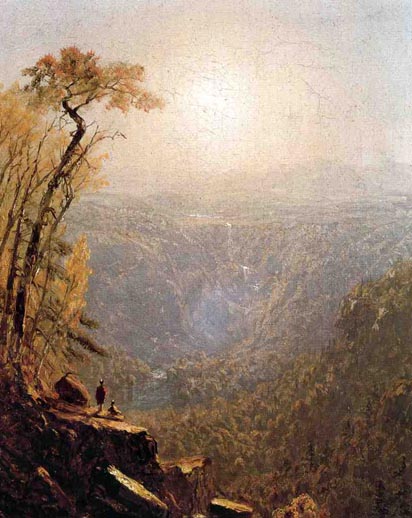
His most important and famous painting, "A Gorge in the Mountains (Kauterskill Clove)," an oil on canvas in the Metropolitan Museum of Art, is a sensational landscape that inspired Eugene Benson, writing in The New-York Commercial Advertiser under the name Proteus, to comment that:
"This picture is a picture of the poet. None more so. And sitting before it, bathed in the affluence and warmth of its light, luxuriating in its color, having our thought steeped in the delicious indolence of its atmosphere, and aroused by the magnificence and wealth of its spirit, we have no care, but, sun-steeped at noon, ask that every pore of our body may became a gate through which sensation may flow, and every nerve an avenue along which may course the subtle messengers charged with the secret of its beauty."
Kauterskill Clove, in the Catskills: 1862 (Two)

Kauterskill Clove: 1850
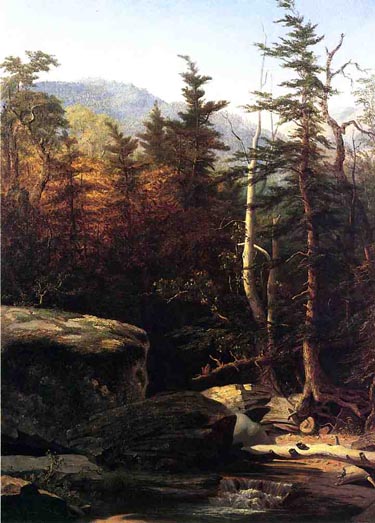
Kauterskill Falls: 1871
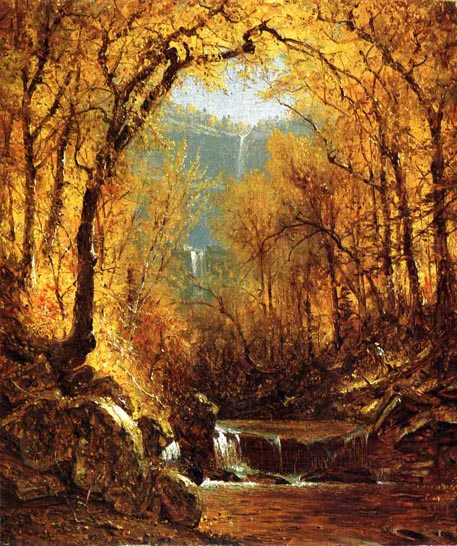
Gifford, of course, did paint the celebrated Kauterskill Falls as evidenced by the lovely small oil he executed in 1871 that is in the collection of the Detroit Institute of Arts.
The catalogue provides the following commentary about this lovely work:
"When Thomas Cole arrived in the Catskills in 1825, probably stimulated like others by (James Fenimore) Cooper's lively descriptions, he made the falls the subject of paintings that earned him his earliest renown. Not long before Cole visited the site, an observation platform had been erected at the head of the falls; later, the proprietor of the Laurel House, built near the falls in 1852, dammed the stream called Lake Creek feeding the cascade and charged visitors for the privilege of witnessing the gushing spectacle that he controlled. The Laurel House was where Gifford stayed with his colleague and friend Jervis McEntee in the autumn of 1871; this excursion resulted in several modest paintings whose subjects, along with a few western and seashore scenes, now formed a minatory among the many more foreign subjects that Gifford was painting and submitting for public exhibition. Gifford's image of Kauterskill Falls here may be marked more by deceit than by truth. He deposits the spectator on lower Lake Creek at the base of Kauterskill Clove for seems an impossibly long view of the cascade, as seen through the trees decorously arched over the stream. (However, it is possible that such a prospect was intentionally cleared for tourists in Gifford's time.)"
A Sketch of Derwentwater: 1855
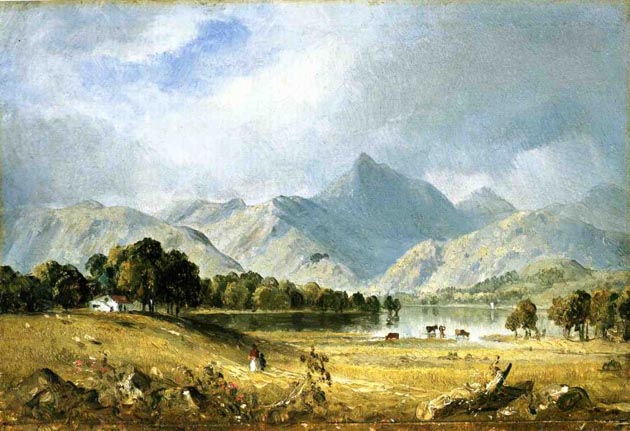
Writing in 1858, a critic praised Gifford's landscape paintings-including this vista of England's popular Lake District-as follows: "His pictures are generally chaste, and unpretending in color, and are remarkable for a luminous atmosphere. Their poetic quality is recognizable in a fine sense of the picturesque, a feeling of repose, and that subordination of minor truths to important truths."
Derwentwater: 1862
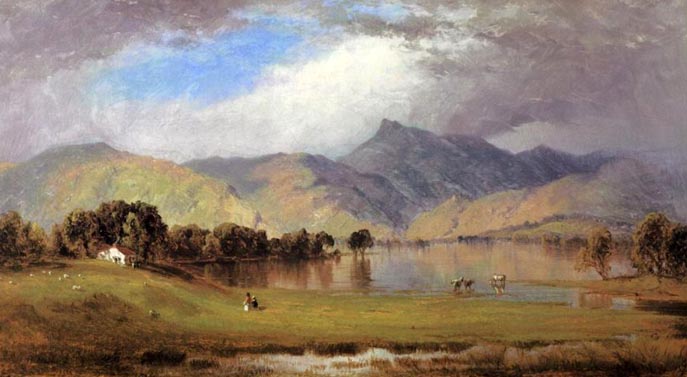
A Sketch of Mansfield Mountain: 1858

A Sketch of Mount Chocorua: 1854
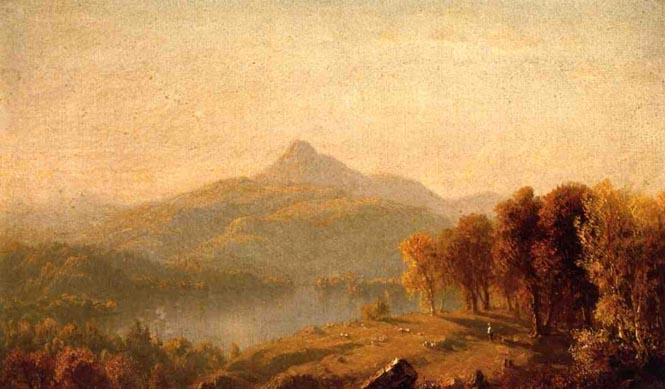
"A Sketch of Mount Chocorua," by Sanford Robinson Gifford was executed 1854-1863. There are many who comment on Gifford's "radiant luminosity," adding that "The painting, with its sophisticated composition, effulgent color and light, and mood of optimism, epitomizes Gifford's contributions to nineteenth-century American landscape art."
A Sketch on the Huntington River, Vermont: 1861

A Sketch on the Nile: 1869
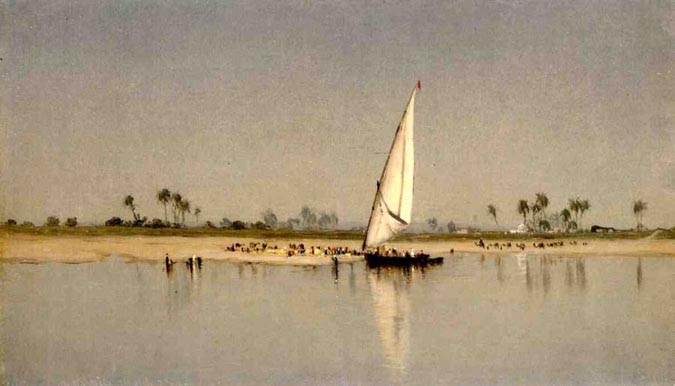
In 1868-69, Gifford made his second and last Old World visit, this time adding an excursion down the Nile in Egypt and stops in Turkey and Greece to his return visits to Italy and other European nations. He lingered some six weeks in Venice, finding himself this time utterly seduced by the so-called Queen of the Adriatic. With its growing reputation as a tourist 'mecca', Venice became a frequent subject in the years thereafter, as did Italian subjects in general, such as the Metropolitan's 'Tivoli' (1869) and 'Isola Bella in Lago Maggiore' (1871), with its coronal sunset effect silhouetting the mountainside that plummets into the lake at left. While in Rome, where he arrived in the company of his friend the artist Jervis McEntee and his wife, Gifford welcomed Frederic Church and his family, who had just completed their circuit of the Holy Land and Asia Minor.
Tivoli: 1870
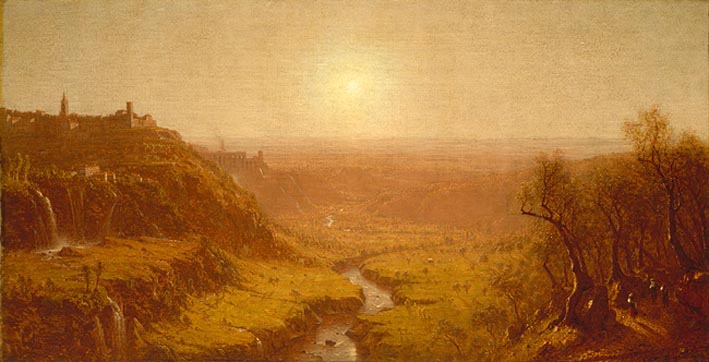
Gifford had visited Tivoli in 1856 on his first trip abroad and, on his second trip a dozen years later, was drawn back, in his words, to "one of the finest views in the world"-the prospect toward Rome overlooking the vale of the Anio (or Aniene) River, past the cascatelle pouring from the arches of the villa of Maecenas. In 1868, he felt discouraged by the variety of detail he then observed versus "the broad and simple splendor of the scene" that he had recalled, and mused: "Whether Art will give me the gorge of the Anio or not is yet to be seen." Two years later, he painted this picture, reprising his own masterly vision of American locales such as his beloved Kauterskill Clove in the Catskill Mountains, the subject of the Metropolitan's Gorge in the Mountains.
Isola Bella in Lago Maggiore: 1871
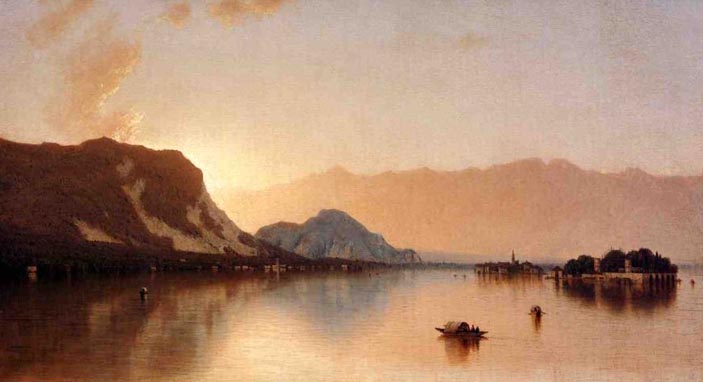
Gifford's second visit to the Italian Lake district in summer 1868 resulted in a painting that contrasts markedly with the pictures done of the same subject matter after his first visit in 1856. In those, taller picture proportions and high frontal sunlight made for bolder, more sculptured mountains and an amphitheatrically disposition of the setting. Here, the sun declining behind the alpine ridges generally flattens the terrain and, except for the warm palette, the picture evokes the landscapes of Gifford's colleague, John Frederick Kensett. Isola Bella is the island at right; with its terraced and pinnacled gardens, it was and remains a popular tourist attraction.
Assouan, Egypt - A Sketch: 1869
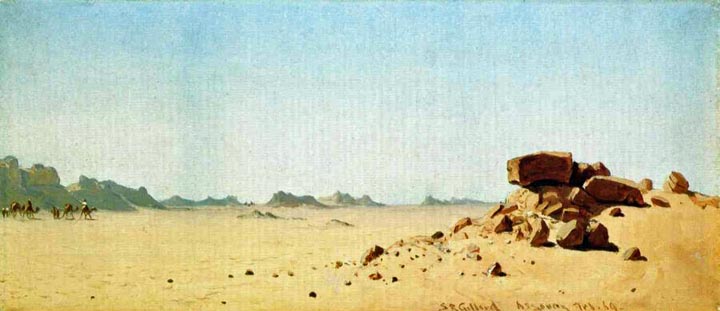
Cardinal's Coach on the Campagna: 1868

Fishing Boats Coming into Brindisi Harbor: 1874
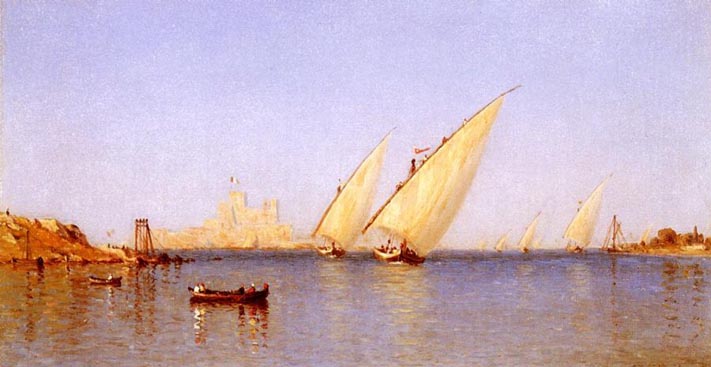
Constantinople, from the Golden Horn: 1876
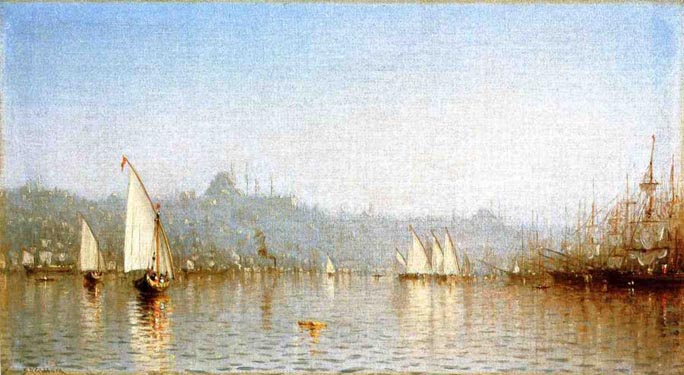
Leander's Tower on the Bosporus: 1876
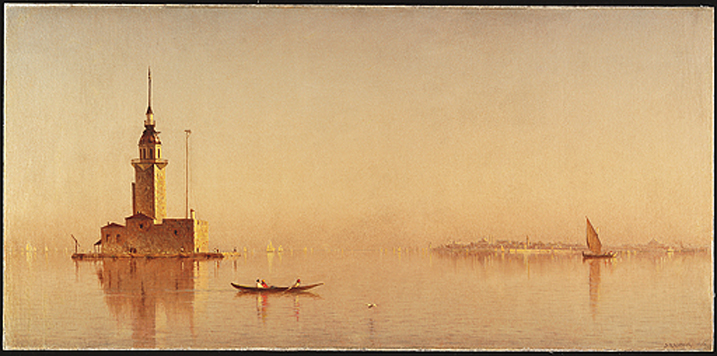
"Leander's Tower in the Bosporus" is one of Gifford's large finished oil paintings. Close inspection shows how Gifford used the same colors for the sky and the water, pink at the horizon fading into blue in both the sky and the foreground. Again he's used texture to differentiate one from the other. The sky is stippled, giving a slightly hazy effect, while the water is painted in smooth horizontal strokes. The buildings on the distant horizon are mere outlines in blue with yellow/orange highlights over a sienna colored under layer. The buildings were left in reserve- there is no sky painted under them, indicating a well-planned out painting.
On the Nile: 1872
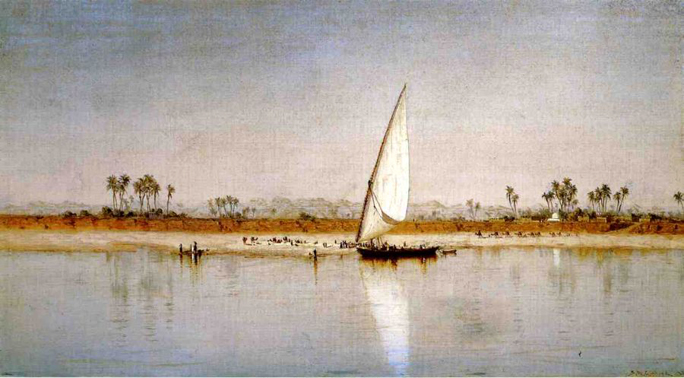
On the Nile, Gebel Shekh Hereedee: 1872
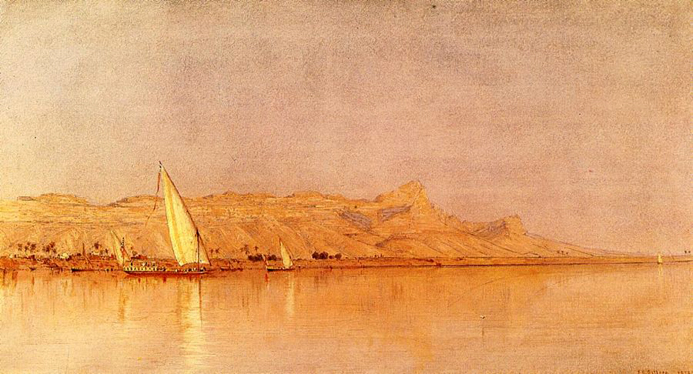
Stelvio Road by Lago di Como: 1868
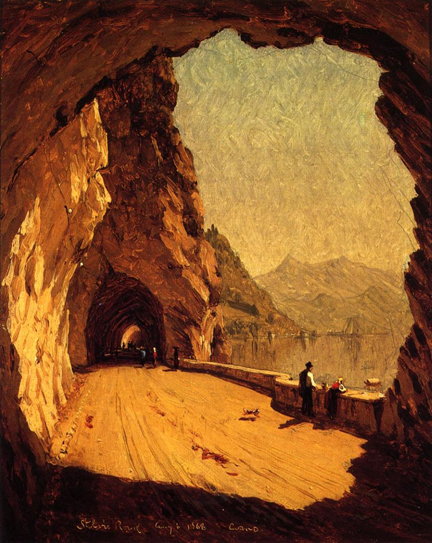
Siout, Egypt: 1874
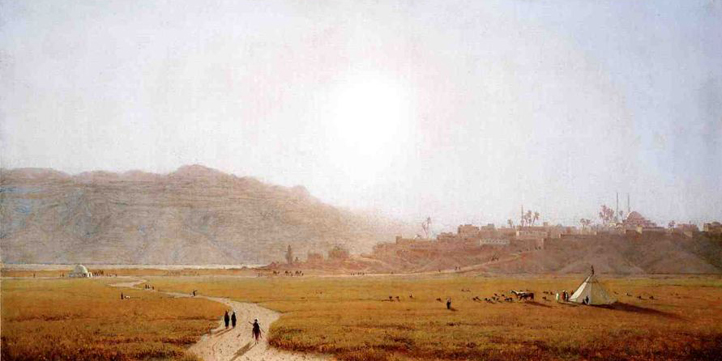
The Galleries of the Stelvio, Lake Como: 1878

The Golden Horn: 1869
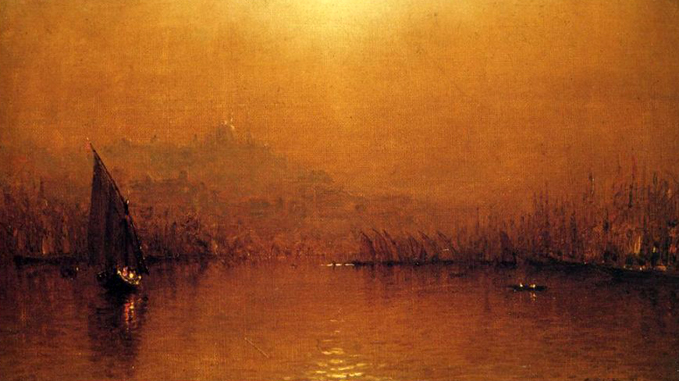
The Road by the Sea, near Palermo, Sicily: 1874

The Roman Campagna: 1859
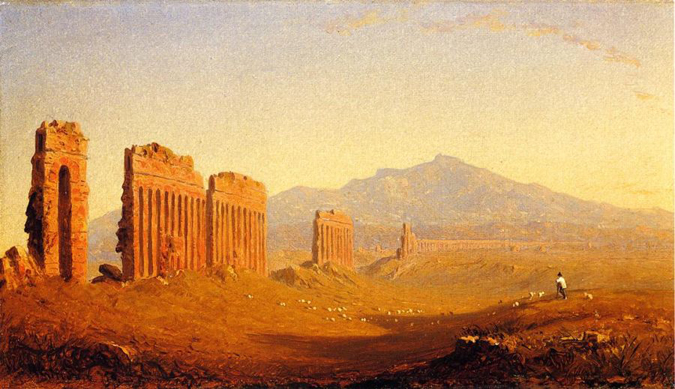
Tombs of the Mameluks

Torre dei Schiavi, Roman Campagna: 1857
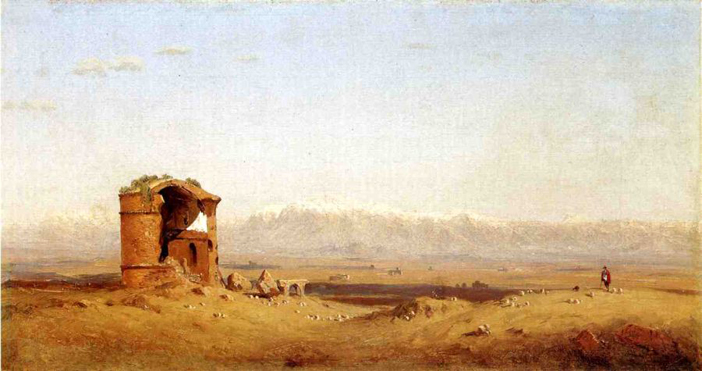
A Forest Road: 1860

A Souvenir of the Catskills: 1867
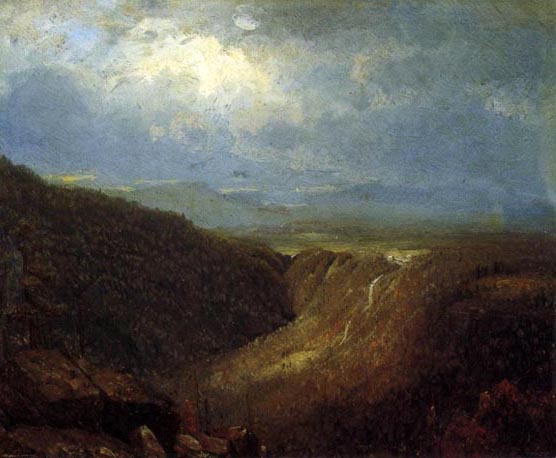
A Study of Rocks at Kauterskill Cove
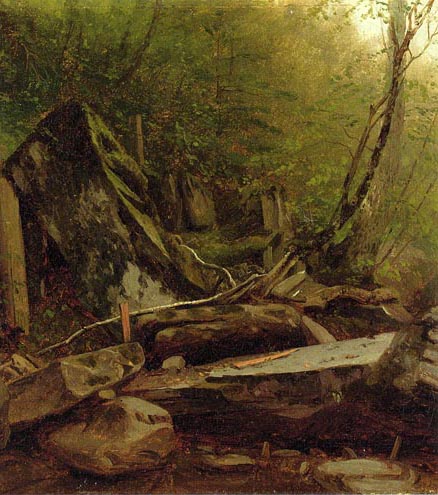
A Sudden Storm, Lake George: 1877
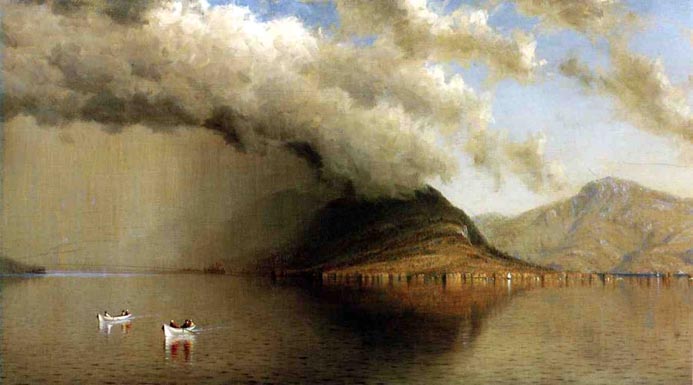
A Sunrise on Lake George: 1877
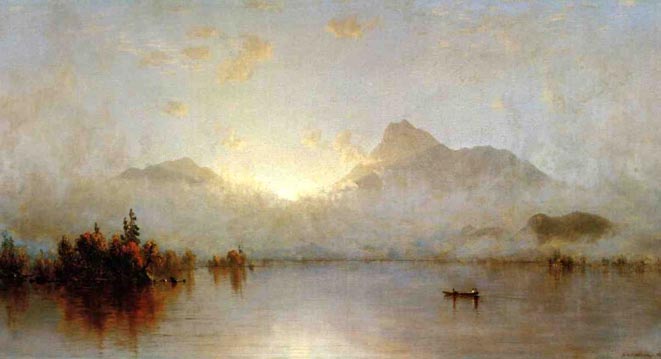
A Sunset, Bay of New York: 1878
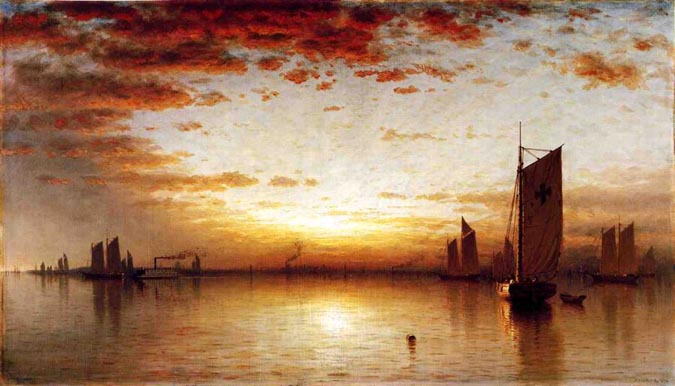
A Twilight in the Adirondacks: 1864
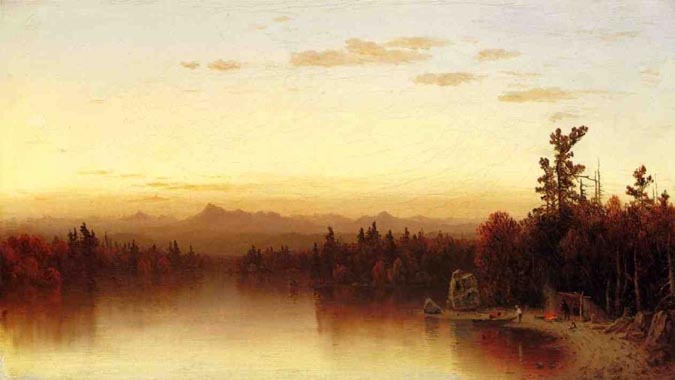
A Twilight in the Catskills: 1861
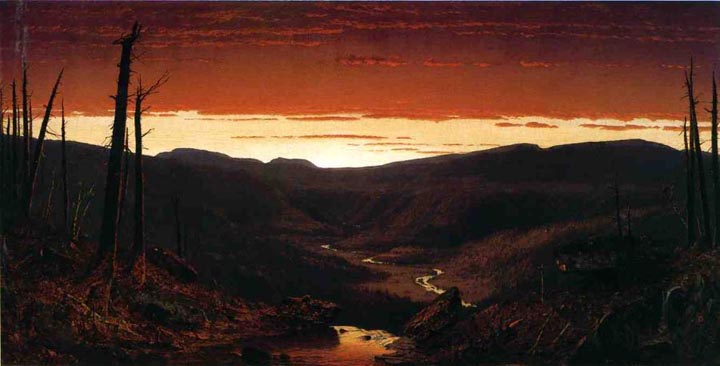
A View from the Berkshire Hills, near Pittsfield, Massachusetts: 1863
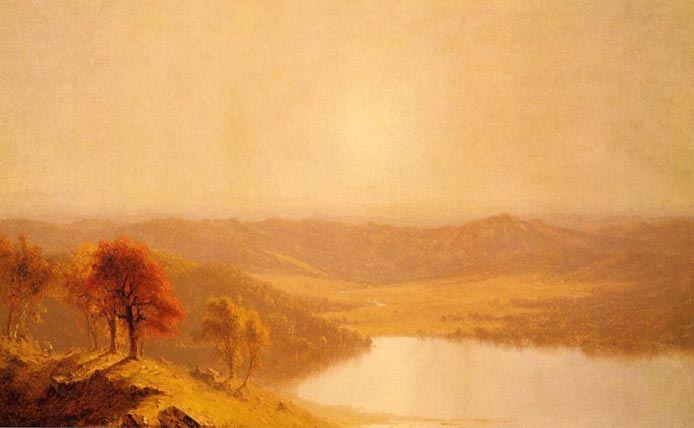
A Winter Twilight: 1862
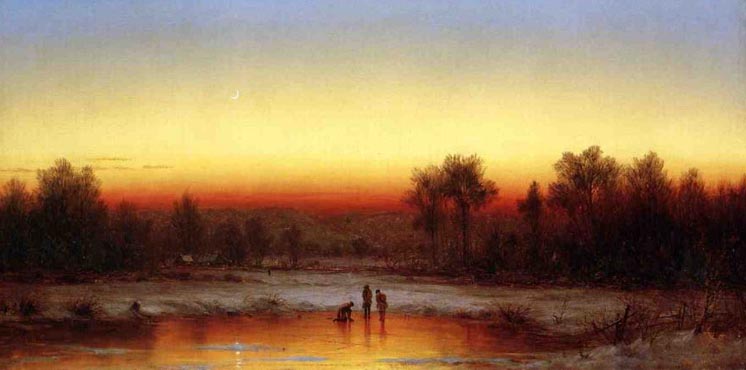
A Winter Walk: 1878
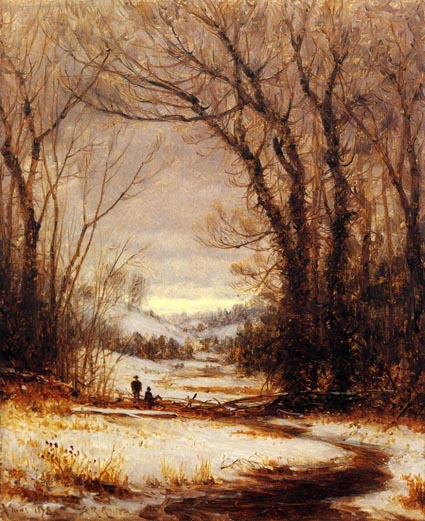
An Indian Summer's Day on the Hudson, Tappan Zee: 1868
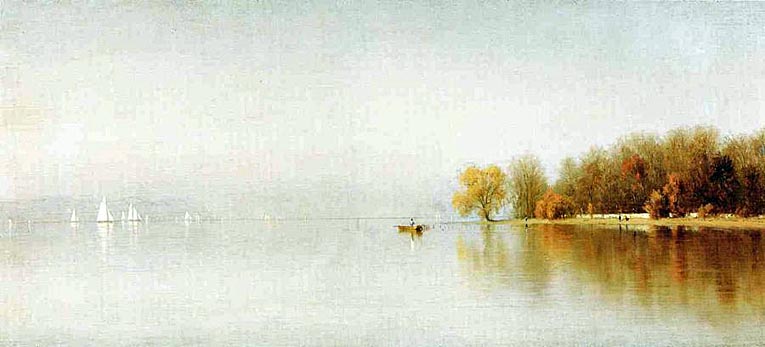
Another Gifford masterpiece is "An Indian Summer's Day On The Hudson Tappan Zee," that was painted in 1868 and is now in a private collection in Washington, D.C.
The catalogue notes that "Gifford's exploration of the possibilities of minimalist compositions was unrivaled among landscape painters of his generation," adding that "Although some of John F. Kensett's 'Last Summer's Work' paintings are equally reductive, they were executed later, and it is unclear whether or not he regarded them as finished." "Kensett did not live to exhibit any of these works publicly, and it is uncertain whether he would have even considered doing so," it continued:
"Tappan Zee" is perhaps Gifford's most beautiful painting. The mountains on the west side of the river are barely visible. The tall white sails of boats in the distance balance the left side of the composition with the autumnal foliage on the right side. The waters are calm. This is a memorable mirage, and definitely more abstract than "Hook Mountain, Near Nyack, On The Hudson," a beautiful 1866 Gifford.
An October Afternoon: 1871
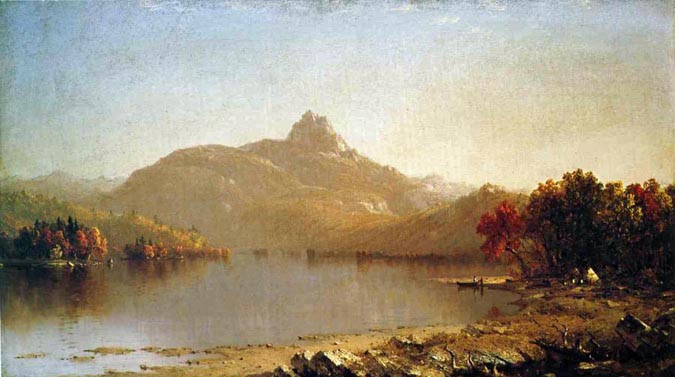
Cape Ann, Massachusetts: 1865
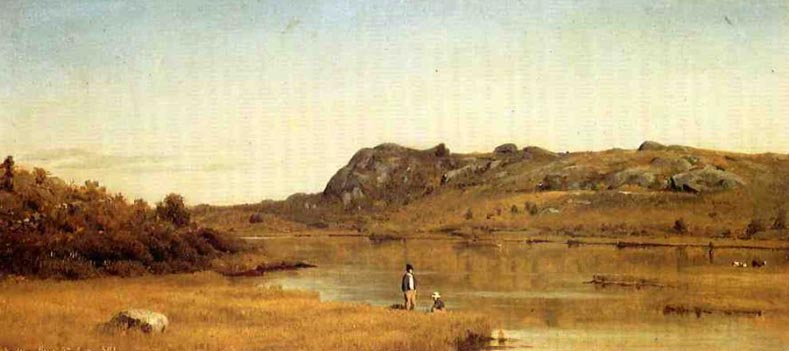
Carriage on a Country Road: 1863
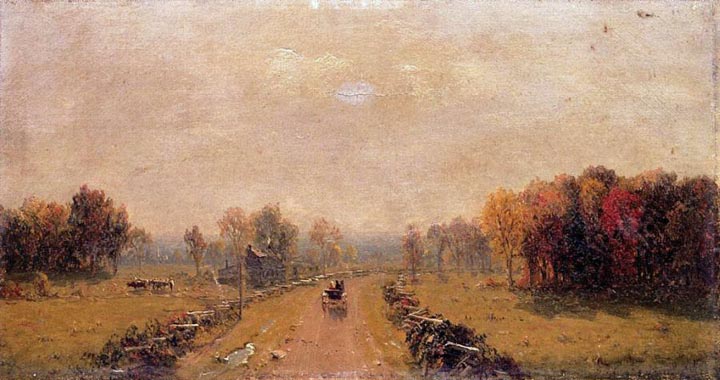
Clay Bluffs on No Man's Land: 1877
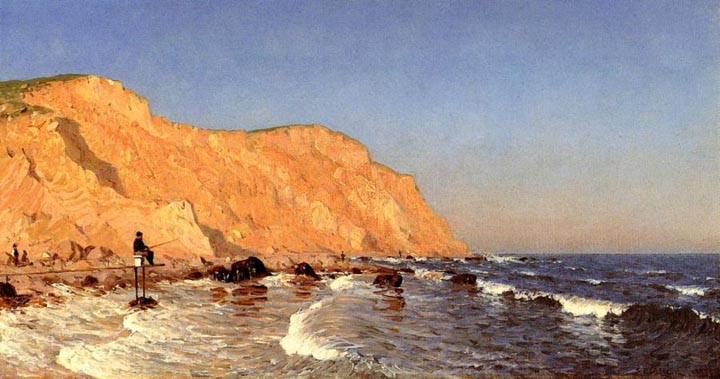
Clearing Storm over Lake George: 1863
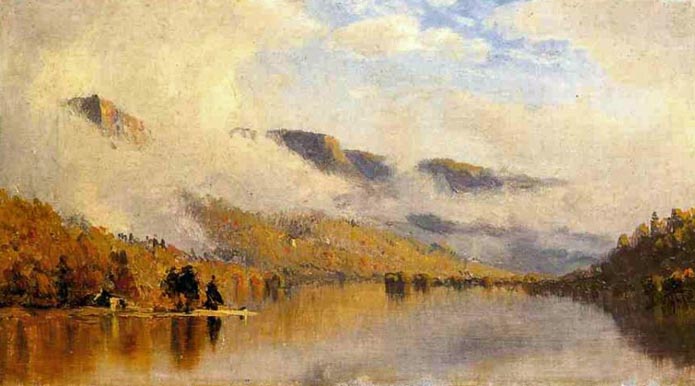
Coastal Sunset

Coming Rain on Lake George - A Sketch: 1873

Coney Island
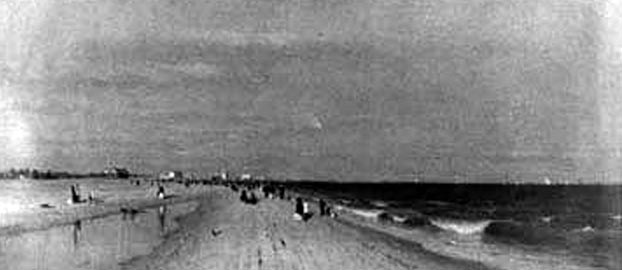
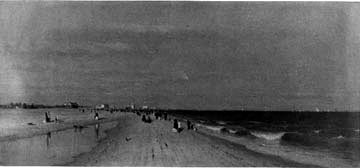
Coney Island ca. 1862 -1865
The sandy strip that became New York City's playground belonged originally to Gravesend, a town established in 1643 by a band of English colonists. Their individual holdings were divided and re-divided among descendants, farmers who paid scant attention to the five miles of non-arable beach to the south.
In 1829, with construction of a shell road, a bridge from the mainland to the island, and an inn named the Coney Island House, New Yorkers began to regard a trip to Coney Island, especially one aboard a breeze-cooled steamer, as an enticing summer escape from the city. At first the domain of the wealthy and prominent (early visitors included Washington Irving, Jenny Lind, and Walt Whitman), Coney Island's further development inevitably brought social changes. By the beginning of the Civil War, it had become a place for romantic assignations and a destination for boatloads of day-trippers of dubious social standing who often behaved rowdily. The opening in 1869 of the earliest train connection, the Brooklyn, Bath and Coney Island Railroad, enabled more visitors to travel there at cheaper rates, assuring the resort a continuous summer flow of middle-class New Yorkers.
In this view of one of America's earliest seaside resorts, probably taken from further east on the island, Sanford Gifford used a horizontal format to emphasize the gently curving beach and lapping waves of the summer seascape. The arrangement of sea, sky, and beach, with only the distant buildings (hotels, bathing pavilions, and other resort delights) for vertical accent, represent elements of Gifford's approach to his many representations of the south-shore beaches of Long Island in the 1860's and 1870's. The softly diffused atmospheric illumination, the great expanses of sea and sky resonant with the effects of light and atmosphere, and a carefully plotted geometric composition combine to achieve the illusion of a motionless moment.
Cows in a Pond at Sunset: 1860

Derwentwater 1862

Early October in the White Mountains: 1860

One of Gifford's loveliest works is 'Early October in the White Mountains'. The 1860 composition is in the collection of the Washington University Gallery of Art in Saint Louis, bequest of Charles Parsons, 1905. Also notable is the simplified geometry that divides the painting into two equal bands of earth and sky, with only the central mountain peaks (which are themselves visually echoed by the placement of the two cows in the foreground) reaching above the center line. The whole scene is expressive of the utmost peacefulness. The smooth lake, the fine mountains, and the motionless trees, all give the impression of perfect repose; while the rich, harmonious tone of color is like a tranquil breath of satisfied completeness.
Fire Island Beach: 1875
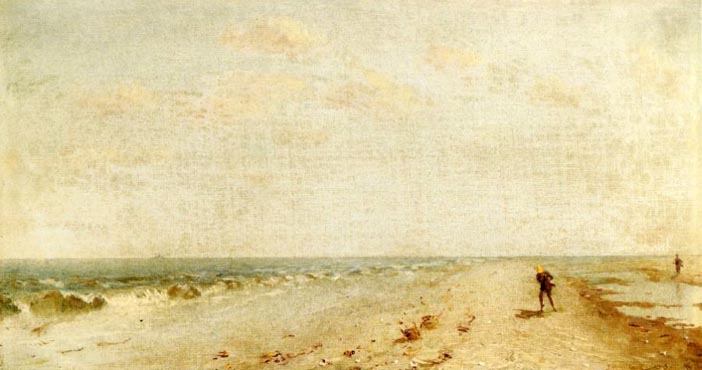
Fire Island Beach: 1878
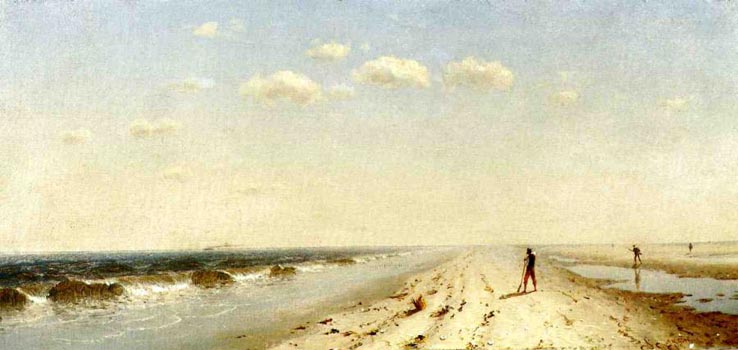
The island is one of Long Island's south shore outer barrier islands, approximately 31 miles long. Fire Island passes through southern Suffolk County, New York, and is southeast of Long Island separated from the main land by the Great South Bay.
Fire Island is about 5½ miles south of the main land of Long Island. It is separated from the main land by a series of interconnected bays: Great South Bay, Patchogue Bay, Bellport Bay, Narrow Bay, and Moriches Bay. The island has very limited access by automobile for day use, from Long Island by the Robert Moses Causeway on its western end to Robert Moses State Park and by William Floyd Parkway to Smith Point County Park near its eastern end. Motor vehicles are not permitted on the approximately 20 miles in between. Essentially the island and its resort towns are accessible only by the numerous ferries.
Hook Mountain on the Hudson River: 1867

"Hook Mountain on the Hudson River"
Sanford Robinson Gifford (1867)
I have felt
A presence that disturbs me with the joy
Of elevated thoughts; a sense sublime
Of something far more deeply interfused,
Whose dwelling is the light of setting suns,
And the round ocean and the living air,
And the blue sky, and in the mind of man;
A motion and a spirit, that impels
All thinking things, all objects of all thought,
And rolls through all things.
Therefore am I still
A lover of the meadows and the woods,
And mountains; and of all that we behold
From this green earth…
from "Tintern Abbey" (Wordsworth)
"I am in awe of autumn. I just stand outside and stare at trees-and keep a lookout for other members of the family who might very well have me committed. But now that I'm no longer in school, I finally have time to enjoy my favorite season. It is all so beautiful. I feel a bit like Wordsworth walking near Tintern Abbey. I can finally understand how those poets felt.
"You know, now that I think about it, it defies understanding to teach the Romantics in a classroom. Sitting in that room, pulling up my knee socks and trying to get comfortable at my desk, I had no feeling for any of them."
From The Day I Became an Autodidact (Hailey)
Hudson Valley Idyll: 1849
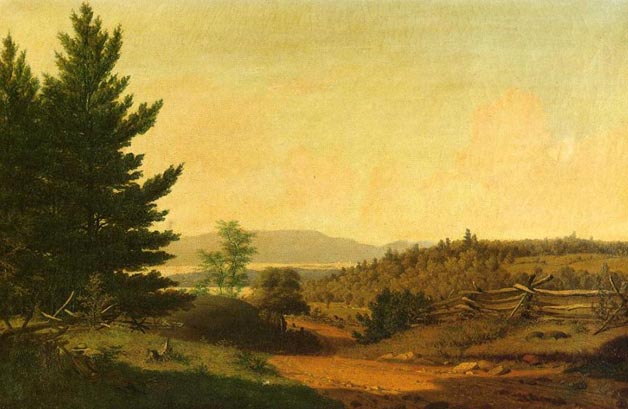
In the Catskills: 1861
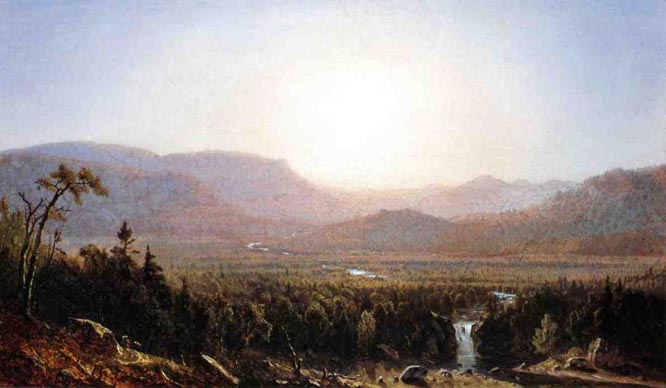
Indian Summer: 1861
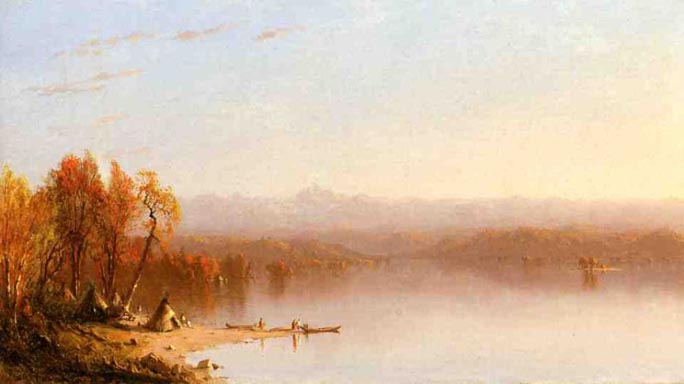
Some of the Hudson River School painters such as Sanford Robinson Gifford (1823-1880) produced excellent paintings of the West was a beautiful small oil by Gifford depicting American Indians and their canoes by the side of a lake beneath a luminist sky.
Indian Summer in the Bronx: 1867

Lake Scene: 1861
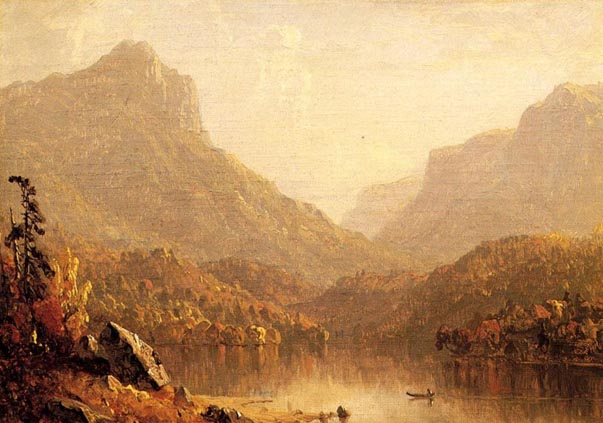
It is nearly forgotten how important New Hampshire's White Mountains were in the middle of the 19th century as a painting destination for the Hudson River School artists. It is still there, and pretty much unchanged since they painted it. Many have found numerous painting locations in those mountains that were painted by Gifford when he visited the White Mountains.
Long's Peak, Colorado: 1870
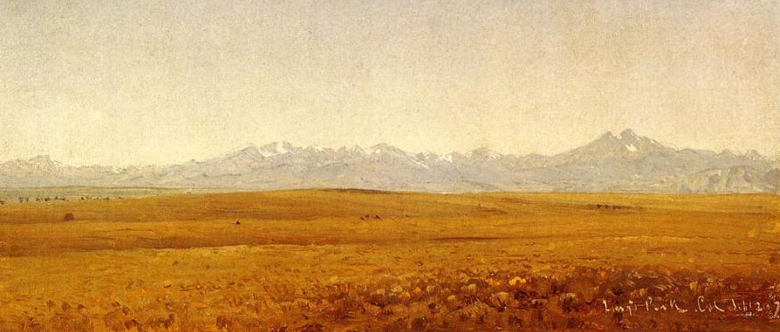
In late 1869 and early 1870 Gifford participated with his colleagues in the formation of the Metropolitan Museum of Art. In the summer he made his first trip to the Far West, accompanying Kensett and Whittredge to Denver.
Manchester Beach: 1865

Marshes of the Hudson: 1876
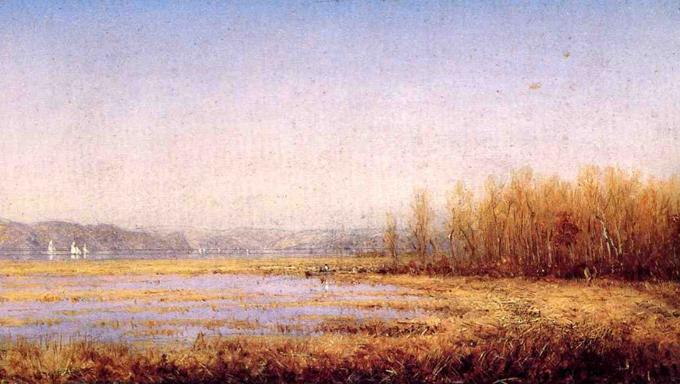
Morning on the Hudson, Haverstraw Bay: 1866
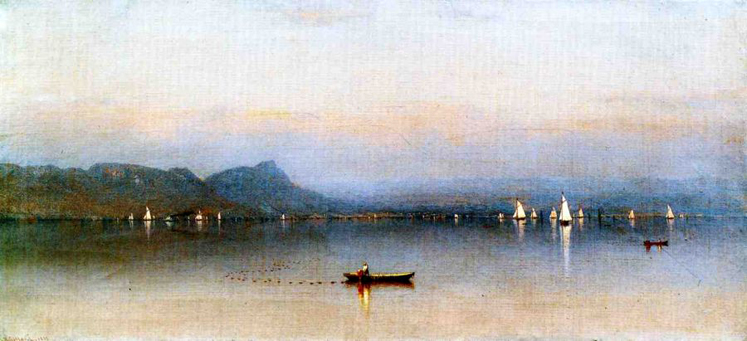
'Tappan Zee' also bears comparison with another 1866 Gifford Work, 'Morning on the Hudson, Haverstraw Bay'. 'Morning on the Hudson' looks northwest from Ossining, New York, from the immediate vicinity of the famous Sing Sing Penitentiary. The focal mountain, on the western shore at Haverstraw, New York, is High Tor, rising more than eight hundred feet above the river. Hook Mountain, viewed from toward the southwest from the southern shore of Croton Point, about two miles north of Ossining, is second in height only to High Tor among the Palisades that line the river's western shore from New York City to Haverstraw. The catalogue suggests that the Haverstraw painting the 'Hook Mountain, Near Nyack, on the Hudson', may have been pendants and states that both remained in the artist's possession until his death.
Mount Chocurua, New Hampshire
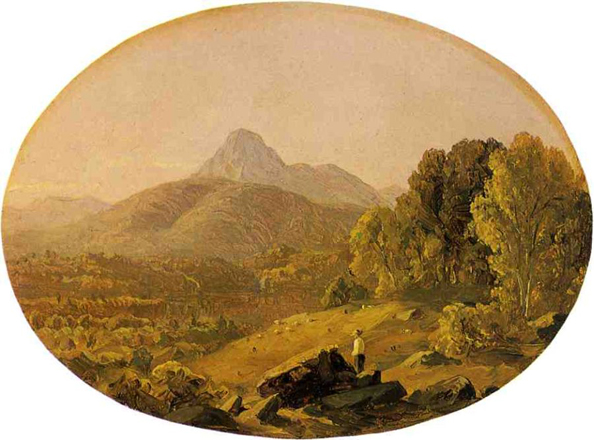
Mount Katahdin from Lake Millinocket: 1879
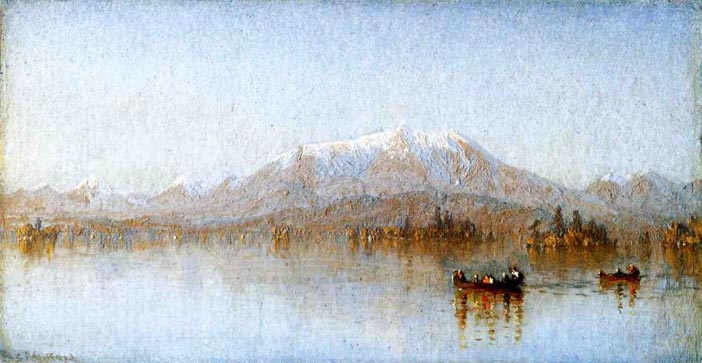
Mount Mansfield: 1859
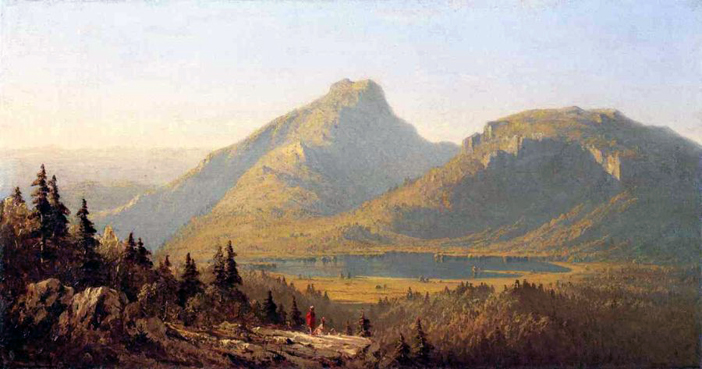
Mount Merino
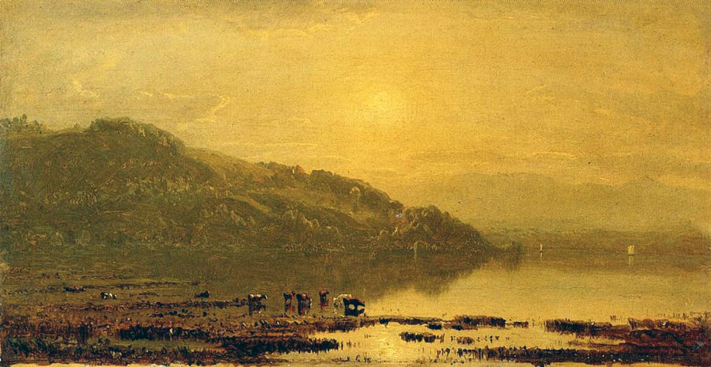
Mount Merino on the Hudson near Olana: 1861
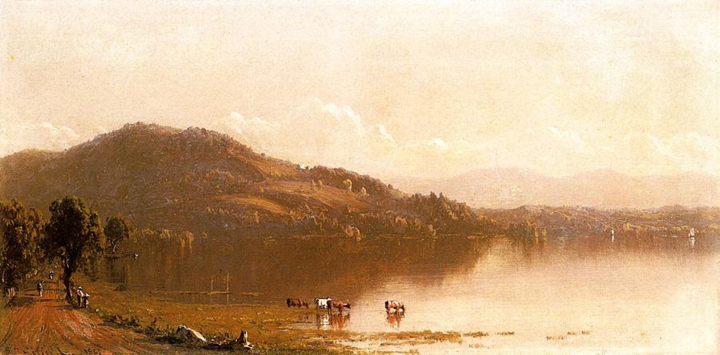
Mount Rainier, Bay of Tacoma, Puget Sound: 1875
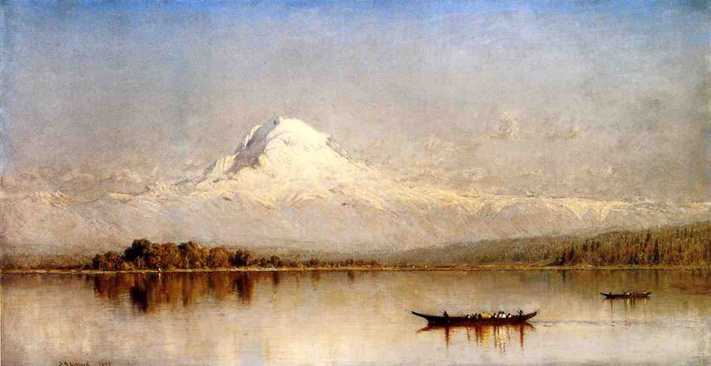
Gifford visited Washington Territory in the summer of 1874, fifteen years before statehood. The drawings he made of Mount Rainier served as models for this painting, which he completed in the winter of 1875 in his New York studio.
Gifford's view of Mount Rainier from Commencement Bay in Tacoma celebrated the grandeur of the Cascade Mountains. He avoided evidence of the rapidly growing lumber town but, like many other artists, included a Romantic vignette of Native Americans. The Far West was majestic and exotic terrain for Gifford and his East coast peers.
Mount Ranier, Washington Territory: 1874
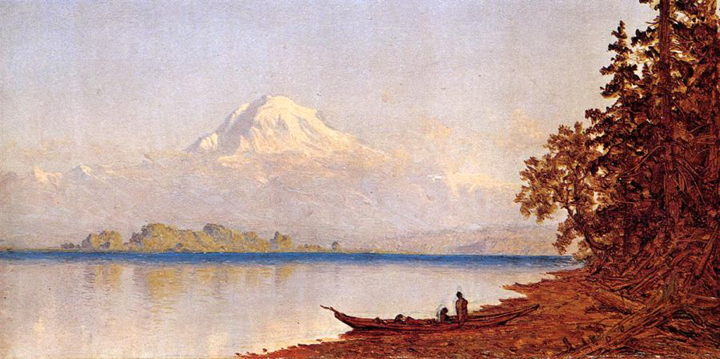
Mount Washington from the Saco River: 1858
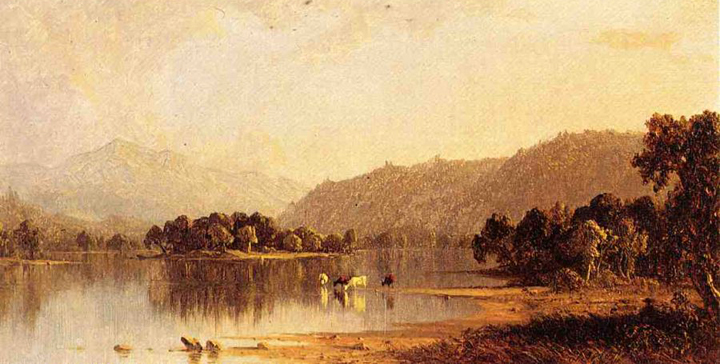
Mount Washington: 1859
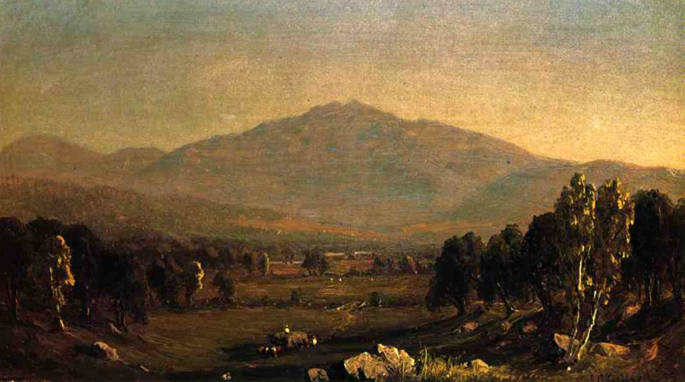
Mount Whiteface from Lake Placid: 1863
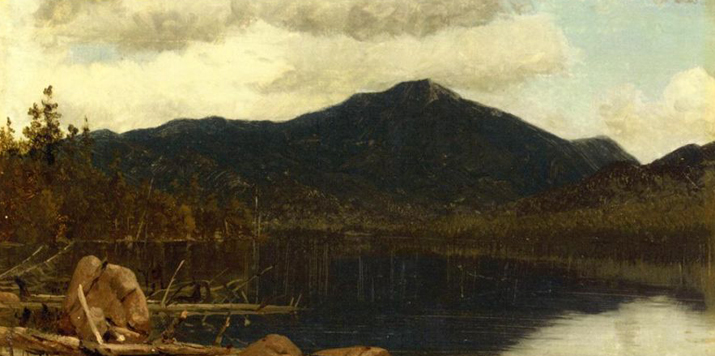
Whiteface Mountain is the fifth-highest mountain in New York State, and one of the High Peaks of the Adirondack Mountains. Set apart from most of the other High Peaks, the summit offers a 360-degree view featuring the Adirondacks and perhaps on a clear day glimpses of Vermont and even Canada.
Whiteface Castle and the Whiteface Mountain Veterans Memorial Highway were Depression Era public works projects similar to the New Deal Works Progress Administration (WPA) projects that followed. Construction on the toll road began in 1929, after passage of a necessary amendment to the state constitution, with a groundbreaking ceremony featuring then-New York State Governor Franklin D. Roosevelt. Eventually costing 1.2 million dollars and ending within 300 vertical feet of the summit the roadway is 5 miles long and features an impressively steep 8 per cent average grade. Officially opened July 20, 1935 in a ceremony featuring Roosevelt, by then President, the highway was dedicated to veterans of the Great War.
Whiteface Castle, built with granite excavated during the road construction, dominates the summit area. From the adjacent parking lot there are two routes to the summit proper. The first route is the Stairway Ridge Trail, a footpath with handrails and intermittent cement and stone steps approximately 0.2 mile long. The second is a 424-foot long tunnel into the core of the mountain. At the end of the tunnel is an elevator, which rises 276 feet to the summit.
No Man's Land: 1877
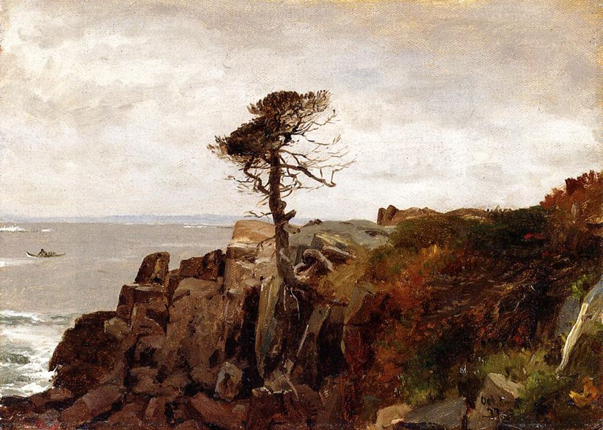
Road Scenery near Lake George: 1849
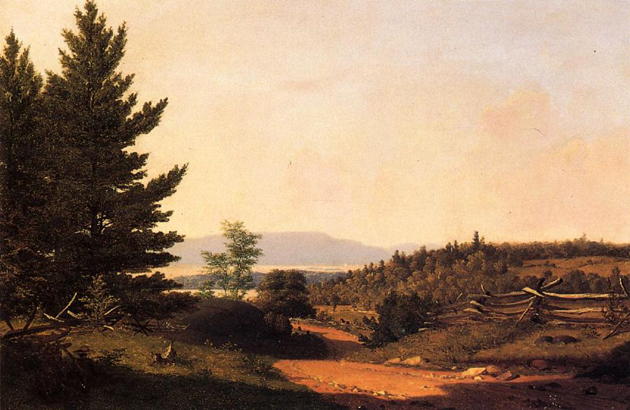
Rocks at Porcupine Island near Mount: 1864
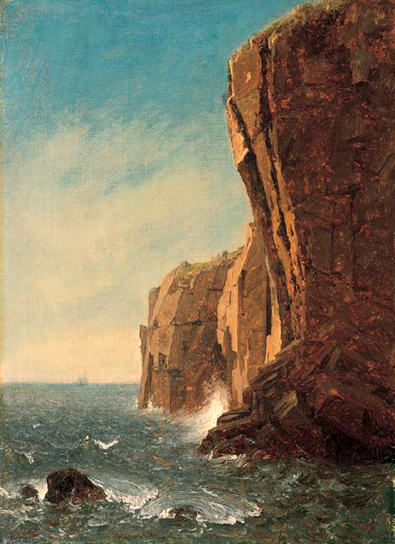
Scene at Bolton, Lake George: 1863
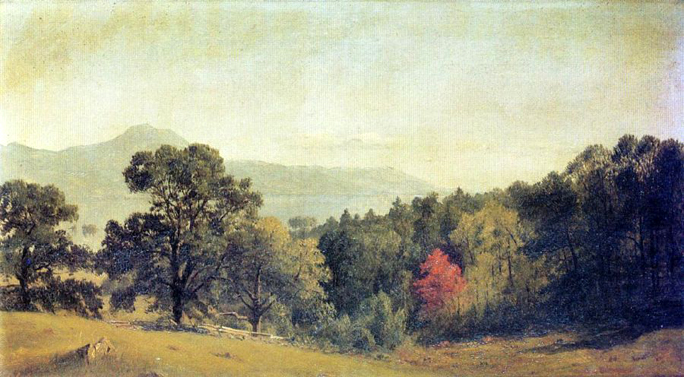
Painting Lake George, 1774-1900 explores, for the first time, the extraordinary depth and range of paintings that depict the 'Queen of American Lakes'. The largest lake in New York's Adirondack region, Lake George with its placid waters rimmed by majestic mountains, was the perfect inspiration for paintings that evoked the sublime wilderness, the beautiful, and the picturesque, as well as the topographical prospect, the panoramic view, and the agrarian ideal.
Scene in the Catskills: 1850


The Catskill Mountains, a natural area in New York State northwest of New York City and southwest of Albany, are a mature dissected plateau, an uplifted region that was subsequently eroded into sharp relief. They are an eastward continuation, and the highest representation, of the Allegheny Plateau. They are sometimes considered an extension of the Appalachian Mountains into Upstate New York, although they are not geologically related. The Catskills are west of the Hudson River and lie within the bounds of six counties (Otsego, Delaware, Sullivan, Schoharie, Greene, and Ulster). The Catskill Mountains are also considered a physiographic (physical geography) section of the larger Appalachian Plateau province, which in turn is part of the larger Appalachian physiographic division.
Sketch of Mount Chocorua - New Hampshire: 1854
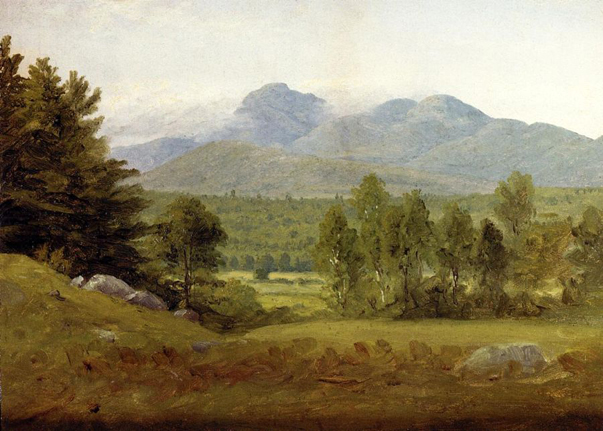
Solitude: 1848
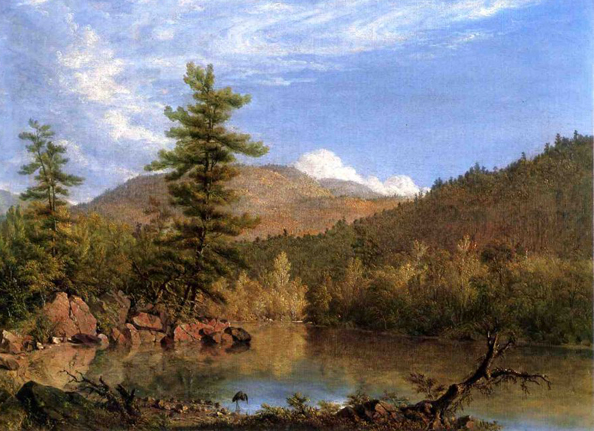
While the collection in which we find 'Solitude' as a whole includes fine representations from each of the developmental phases of American landscape painting, with a lesser amount of other genre, several works stand out. Members of the Hudson River School found great inspiration in the close observation of nature and deified it in large-scale paintings. A remarkable early Sanford Gifford, possibly a tribute to his teacher Thomas Cole, is 'Solitude', painted in 1848. Gifford's evocative rendering of the Catskill scenery, the dead tree in the foreground symbolizing the passage of time, the lack of anything human, lone bird - all denote a superb example of this very American painting movement.
South Bay, on the Hudson, near Hudson, New York: 1864

The Evil Consequences of Man's Improvidence: Sanford Gifford, the Hudson Iron Company, and South Bay
Storm King of the Hudson: 1865
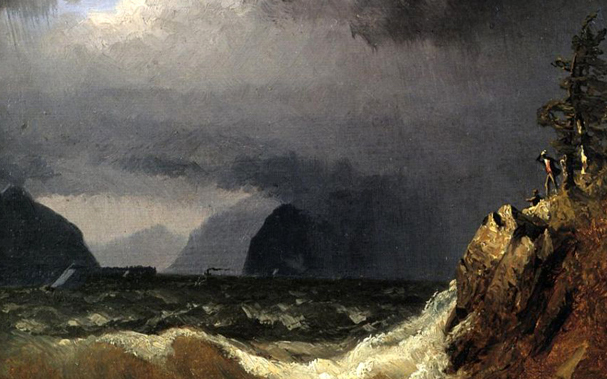
Study for the View from South Mountain, in the Catskills: 1873
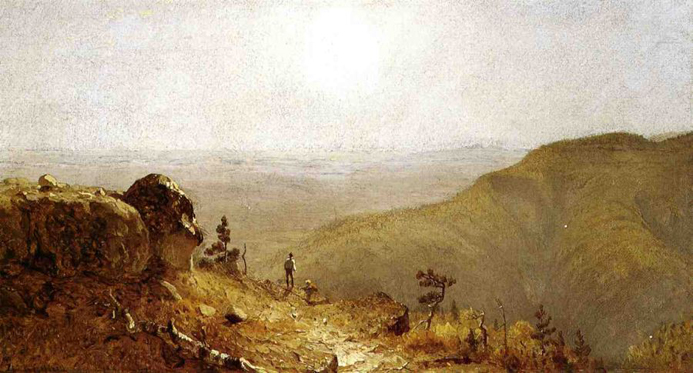
Study on the Massachusetts Coast: 1870
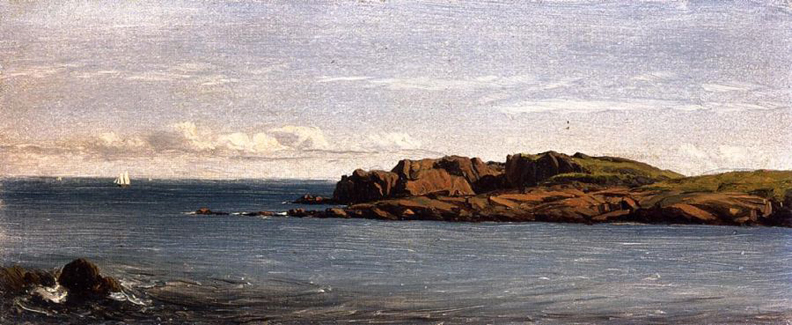
Summer Idyll: 1860
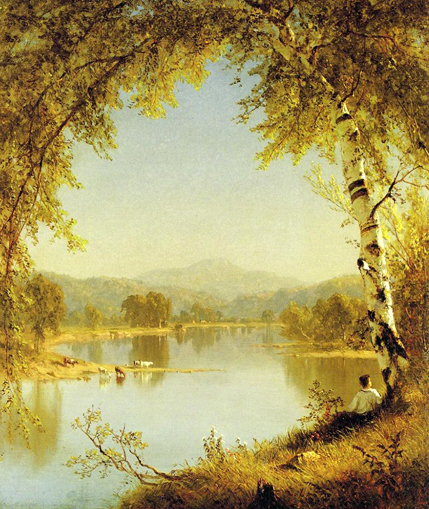
In a classic Hudson River School work by Gifford. Entitled 'Summer Idyll', it incorporates his luminous sky and brilliant coloration. Gifford cloaks the landscape of 'Summer Idyll' in a serene light and hazy atmosphere evoking a soft and poetic mood. Divine and pristine, the landscape appears to be untouched by the hand of man; however, a sole isolated figure under the tree in the foreground indicates the onset of man's encroachment on paradise. Gifford emphasizes closely related values in order to create a feeling of unity as well as to reveal nature's harmonious interworkings. Through his rich depiction of luminous light, Gifford is suggesting a transcendental notion of the passage from God to Nature to Man.
Sunset: 1863
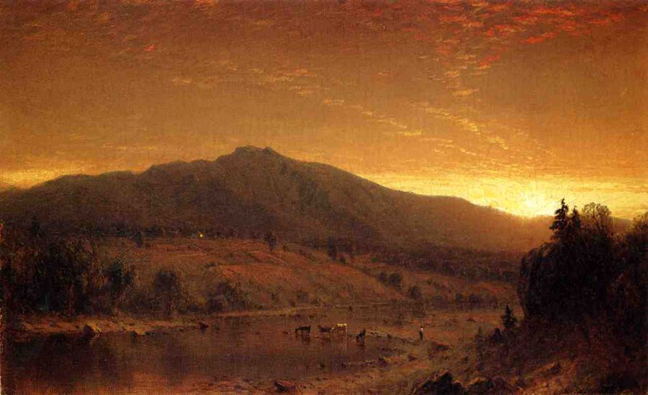
Sunset in the Adirondacks

Sunset on the Shore of No Man's Land, Bass Fishing: 1879
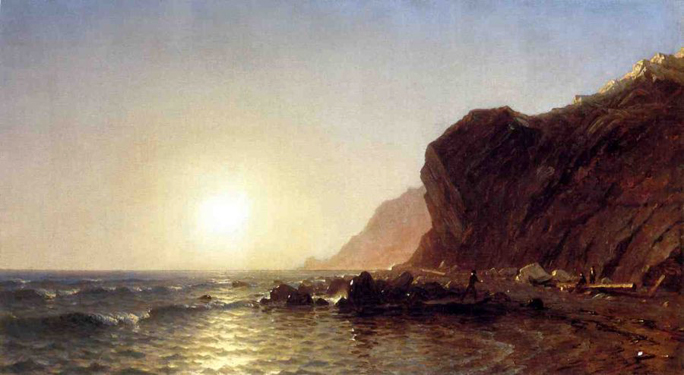
Sunset over the Palisades on the Hudson: 1879
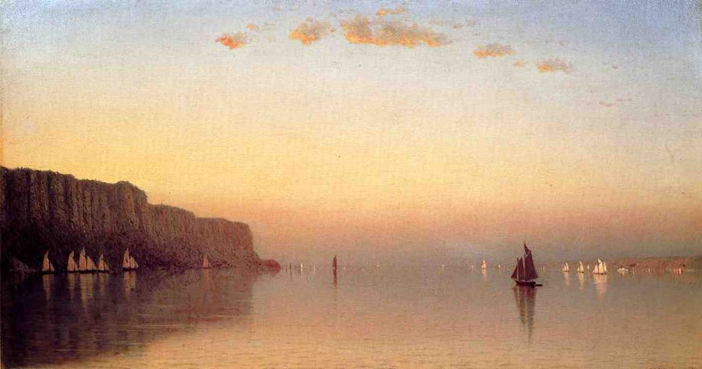
A much later work, 'Sunset Over The Palisades On The Hudson', that he painted in 1879, is the quintessential Gifford painting, an evocative work that epitomizes the glories of the Hudson River and the lush nostalgia of approaching twilight. Like many of John F. Kensett's Luminist shore scenes, Gifford has pushed the landmass to one side and slightly animated the waters with sailboats and the sky with minimal clouds.
The Artist Sketching at Mount Desert, Maine: 1864
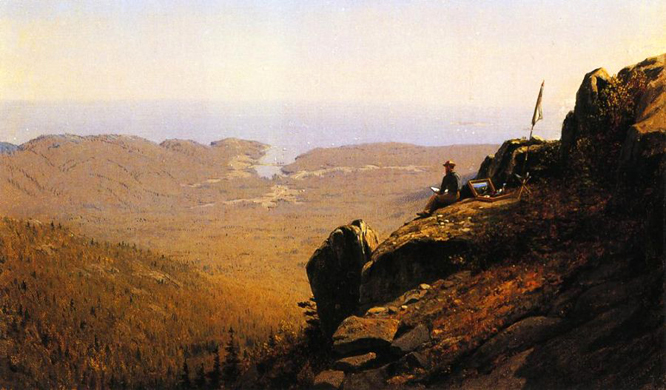
The River Bank: 1854
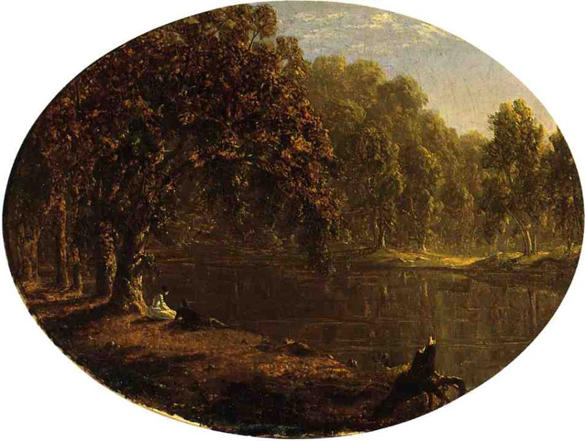
The Shawangunk Mountains: 1864
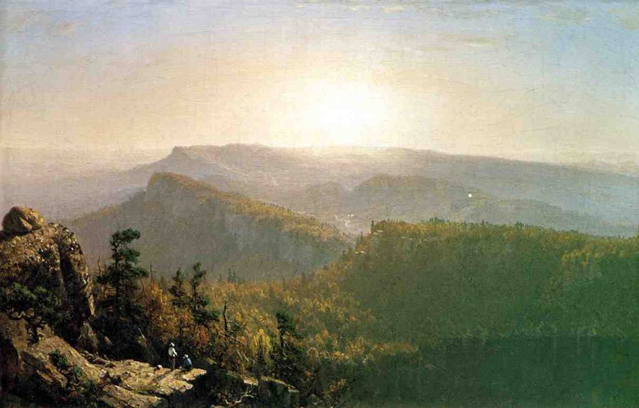
The Top of Kauterskill Falls: 1850
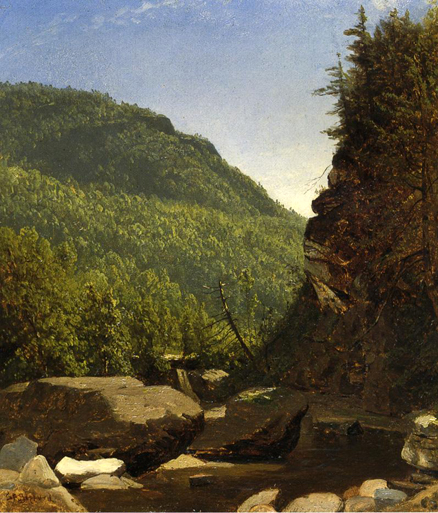
Gifford's works tend to be idealistic merely than strictly representational and are characterized by a poetic serenity in which reality is distilled into an imagined "perfection" of scene. Gifford, however, was not formulaic and at times produced some works that were markedly and aggressively different from his normal late afternoon pastoral scenes.
The View from South Mountain in the Catskills, A Sketch: 1865
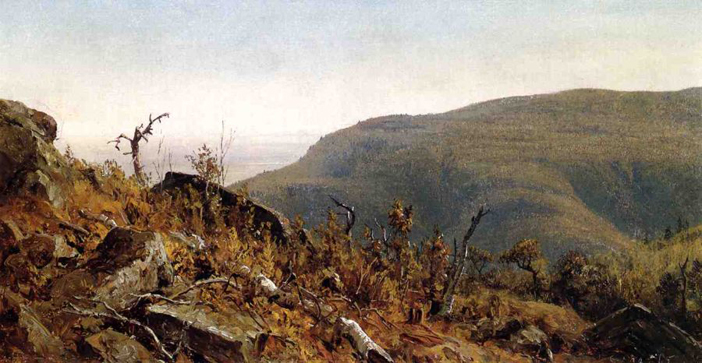
The Wilderness: 1860
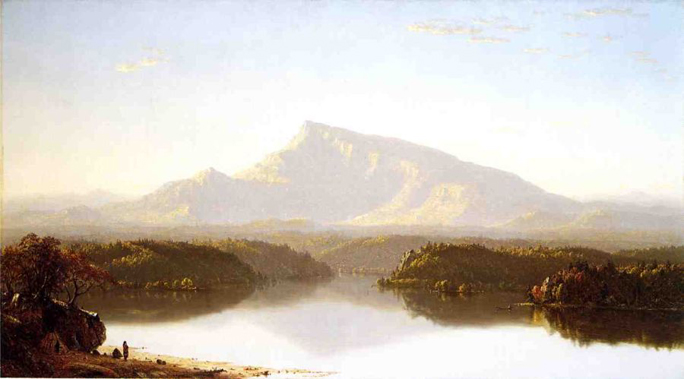
Toung Mountain, Lake George
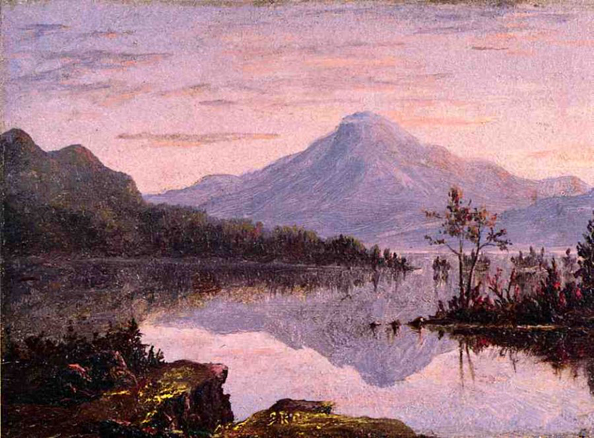
Twilight: 1867
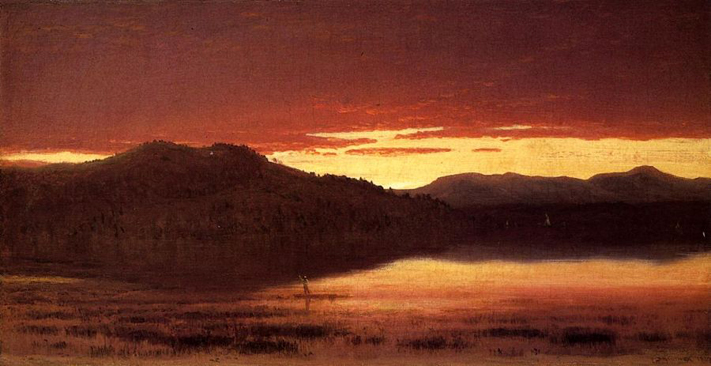
Twilight on Hunter Mountain: 1867
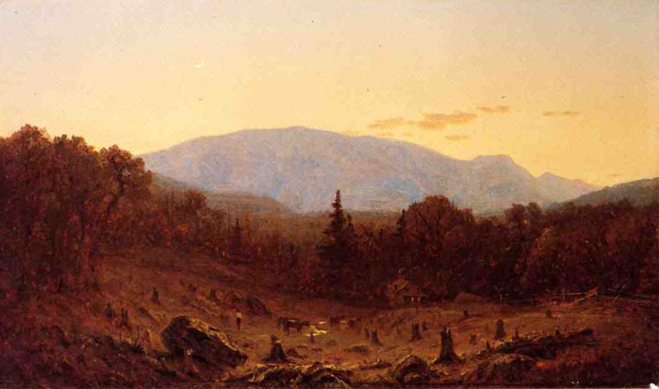
Hunter Mountain, Twilight
Seldom does a single work of art have any kind of lasting impact upon a nation's social, political, or environmental course, especially in today's media-driven public consciousness. This, however, is the story of a painting that moved a nation. In 1866, Sanford Robinson Gifford painted Hunter Mountain, Twilight. Gifford was a card-carrying member of a late generation of painters of the fabled Hudson River School. But if the title of this painting brings to mind any kind of breathtaking, pristine wilderness scene reminiscent of Thomas Cole or Frederic Edwin Church, think again. Picture a bright, twilight sky, a distant, bluish mountain of modest proportions, and a landscape where the predominant colors are not deep forest greens but brownish, tannish earth tones with far more tree stumps than trees. This was Hunter Mountain as Gifford saw it and painted it shortly after the Civil War. And lest you link the two, although it might look like one, Hunter Mountain was in no way a Civil War battleground. It is in an area about a hundred miles or so north of New York City, overlooking the West bank of the Hudson River. It was a wilderness all right, but desolate, not pristine. It was a shameful mark of just how low we had sunk as guardians of the virgin landscape we had taken control of from the natives little more than a hundred years before.
In the years following the Civil War, much of the state of New York was overrun with small farms, strip-cut logging, erosion, and in some areas, early forms of industrial water pollution. About 75 percent of the state's once-forested areas were a thing of the past. New York, and the lower Hudson Valley in particular, were some of the first documented areas of large-scale ecological destruction in this country. And one of the men responsible for this sad state was James Pinchot, a New York City logging and lumbering millionaire. He bought 'Hunter Mountain, Twilight' from the artist sometime during the 1870's and the painting was to remain in the family for the next 90 years. His son, Gifford Pinchot, was born in 1865, the year Sanford Gifford made his first sketches for the painting. The boy was named after the artist. But if James Pinchot was an early "robber baron", he was not one without a conscience. He was also an art collector and in his later years, one of our nation's first conservationists. He helped found Yale University's School of Forestry and persuaded his son to go into the field.
'Hunter Mountain, Twilight' was a sort of "smoking gun," in effect, tangible proof that not only had the nation failed miserably in protecting its birthright, but that something had to be done to correct such a grievous sin. What remained for Pinchot the younger to do was to stir the political pot and prove that something could be done to repair the gross damage of a century of environmental rape. Gifford Pinchot took the family calling much further than even his father could have imagined. In the turn of the century Progressive era of American politics, President Teddy Roosevelt made him the first head of the newly established United States Forest Service. Later, he was twice elected Governor of Pennsylvania. And for a generation he was the most well known spokesman for conservation in the entire nation - with the possible exception of naturalist John Muir.
Muir was to the West what Pinchot was to the East and yet the two men were always at odds in their conservation philosophies. Pinchot saw the forests as renewable, manageable resources to be used and cultivated. Muir was more extreme, insisting that the wilderness should be left untouched by man in its most pristine state. Muir saw the devastation of 'Hunter Mountain, Twilight' and vowed to protect his Sierra Nevada Mountains from such a fate. Pinchot saw his work as correcting the desperate problems of Hunter Mountain and the plundered Eastern landscape while controlling the various economic forces so that both might thrive. And both men (and their followers) have been successful. Today, photos of Hunter Mountain show a rich, vibrant, reforested green. The small farms have been abandoned; the Adirondacks have become a woodland recreation area. Large scale lumbering has largely moved to Muir's backyard where, ironically, Pinchot's forest management philosophy prevails - a shifting from art to science. And just as ironically, Muir's pristine wilderness ideals now dominate the area just north of New York where the city has been buying up thousands of woodland acres to protect its natural water supply and avoid the cost of large filtration plants. And in doing so, it has necessarily placed these areas off-limits to hiking, camping, and other forms of human encroachment.
Today, Hunter Mountain and 'Hunter Mountain, Twilight' are both safe. In some areas near the mountain trees are often so dense you can hardly even see the mountain. And with the death of Gifford Pinchot in 1946, and his wife, Cornelia, fourteen years later, the painting was literally ripped from the mantel of the Pinchot home where it had been framed into the paneling for decades. Twice it was resold in the 1980's. It now rests in Chicago's Terra Museum of American Art. The National Forrest Service inherited the rest of the Pinchot art collection. Unfortunately, these Hudson River landscapes, numbering over 200 works, did not enjoy the same good fortune. In fact, they've all disappeared. Twenty-five years ago, works by Hudson River School artists were out of favor. Appraisers valued them as worth no more than the canvas they were painted on. Pinchot family members believe they may have simply been left in the basement of the house where they were stored and been bulldozed over when the structure was demolished and the area reforested. Today, such nineteenth century Hudson River School paintings often bring five and six figure bids at auction. Thus, in the greatest irony of all, valuable art was likely sacrificed in the name of conservation.
Humanities Web
Contributed by Lane, Jim
Twilight Park: 1860
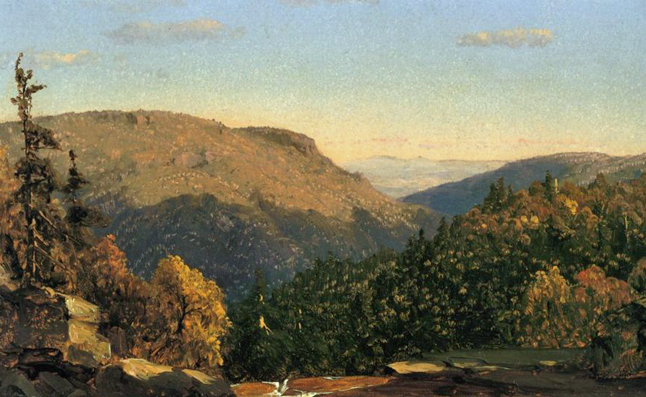
Valley of the Chug Water: 1870
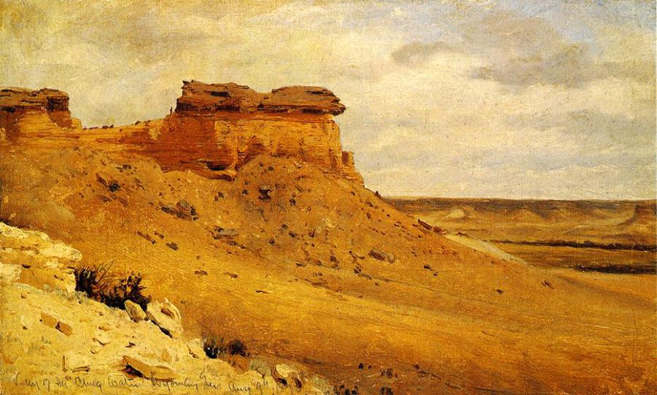
In 1870, on a side trip, the Hayden Expedition (Sanford Robinson Gifford took part in this Expedition) passed through the valley of the Chug, at the time, the cattle industry in Wyoming was only in its infancy. It has been noted that in 1870 there were but 8,140 cattle in the entire territory. Nevertheless, Hayden's photographer, William Henry Jackson, in his description of the valley, noted that it was already a wintering area for cattle:
"A very conspicuous feature which we notice in descending the valley of the Chug is the high bluff of Lower Cretaceous sandstone, which stretches away toward the northeast like a high wall. The bluff itself is so regular that it presents the appearance of massive mason-work gradually falling to decay. The sides of these sandstone walls are from 40 to 60 feet perpendicular, sometimes overhanging, large masses of which have broken off and fallen to the base. Their most striking feature, however is to weather into most picturesque castellated forms. The valley of the Chug is 100 miles long, and is a favorite place to winter stock."
Cattle were allegedly first wintered over in the valley as early as 1859. The town of Chugwater, itself, is named after Chugwater Creek. The area, however, due to its proximity to Fort Laramie, had been explored in the early expeditions, including that of Stephen Watts Kearny in 1845. Thus, William B. Franklin's map accompanying Kearny's report shows the Chugwater, although spelling it as "Chagwater." The popular version of how Chugwater received its name is that the word "Chug" is an onomatopoeic version of the sound of a bison hitting the ground from an Indian buffalo jump.
View near Kauterskill Clove: 1878

View of Catskills: 1860

Mrs. Sanford Robinson Gifford
(Mary Cecilia Gifford): 1878
_1878.jpg)
Source: Art Renewal Center
Source: Web Gallery of Art
Return to Pagina Artis
Return to Bruce and Bobbie's Main Page.